:max_bytes(150000):strip_icc():format(webp)/apple-tvos_a-star-is-born_060319-b01aea7d8a1949609359d8d96b1a22e0.jpg)
2024 Approved Resize and Refine The Art of Cropping Videos in Avidemux

Resize and Refine: The Art of Cropping Videos in Avidemux
How to Crop a Video with Avidemux

Ollie Mattison
Mar 27, 2024• Proven solutions
Cropping a video, to bring focus onto the important aspects and remove the extraneous parts of the scene, is one of the most valuable tools available to a video editor. It can be used as mentioned to ensure the viewer focuses on what is important, but also to magnify objects on the screen, such as with footage of nature. It has many uses, and one of the best tools available for cropping video is the free program Avidemux. Here we are going to go through the process of getting Avidemux running on your system and cropping some video.
If Avidemux is too complicate for you, you can consider Wondershare Filmora , which is an easy-to-use video editing tool to crop videos within several click. Download the free trial version blow.
 Download Mac Version ](https://tools.techidaily.com/wondershare/filmora/download/ )
Download Mac Version ](https://tools.techidaily.com/wondershare/filmora/download/ )
How to Crop a Video with Avidemux
1. Installation
You can find Avidemux for download here , it is available for a wide range of platforms, just download the version that fits your needs. Once downloaded, install in the standard way for your platform, this is the Wndows version (64bit).
One point of note during installation is that you can choose which parts of the program you wish to install. It is a very small footprint and for the best performance it is wise to simply install everything.

Once installed you will be presented with the program as seen here.

2. Importing Video
The next step is importing video. This can be done in two ways, by clicking the file folder icon at the top left you open a standard file browser to navigate to, and select your chosen video file, or alternatively you can simply drag you video into the main panel to import it.

Whichever route you take, you will end up with your video file loaded in like this.
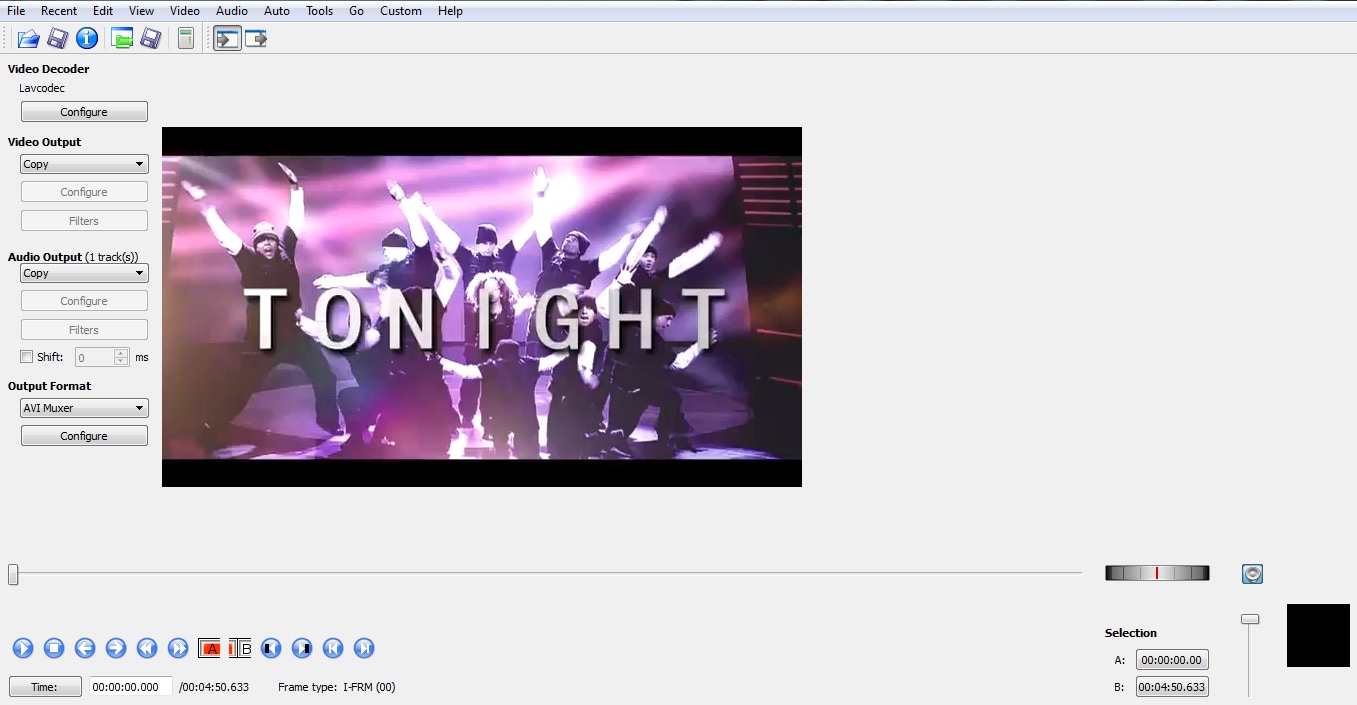
Now you can edit the video as you need, Avidemux contains a wealth of features to enable the full spectrum of editing tasks to be completed. However, here we are going to look at the cropping tool, so on to the next step.
3. Editing Video
Avidemux has some idiosyncrasies in terms of operation, one of those is that to be able to edit any video, you have to choose your output format. Don’t worry though, this is easy, just use the dropdown at the side to choose the output format you want as can be seen here.

Once that is set you are free to start editing your footage.
4. Cropping
It is important to understand how the editing process works in Avidemux, everything is accessed via the filters menu Video>Filters and from here you are faced with a new interface that enables you to choose the component you wish to use.

Selecting ‘Crop’ from the menu and pressing the green plus symbol at the bottom activated the crop tool and presents you with yet another view that allows you to adjust the crop to your tastes.
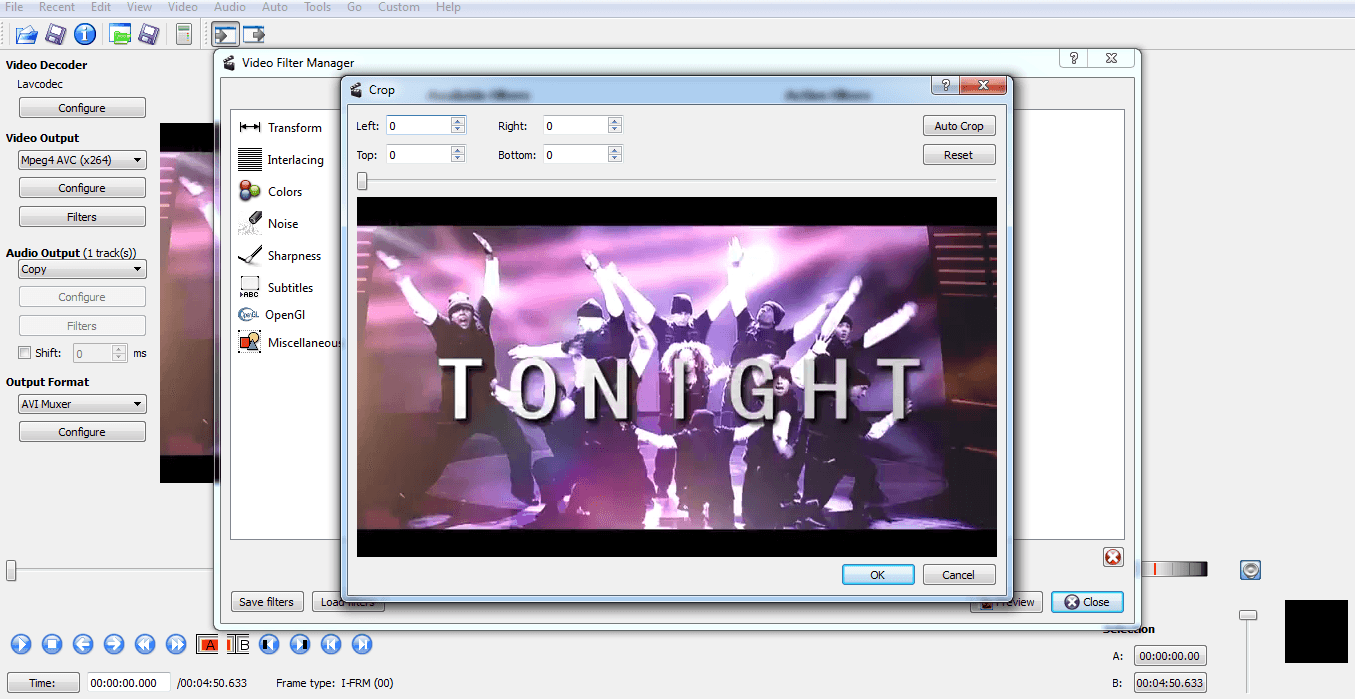
5. Cropping controls
There are two options for cropping, you can use the Auto crop feature, which will detect any black lines and crop the footage between them, or if you are using the crop tool for something else, or just want to do it manually, you can set the crop via the left right top and bottom boxes. Values input here are the number of pixels from that edge the crop extends, as you are setting it, this is displayed with a green block signifying the area of the image that will be removed.
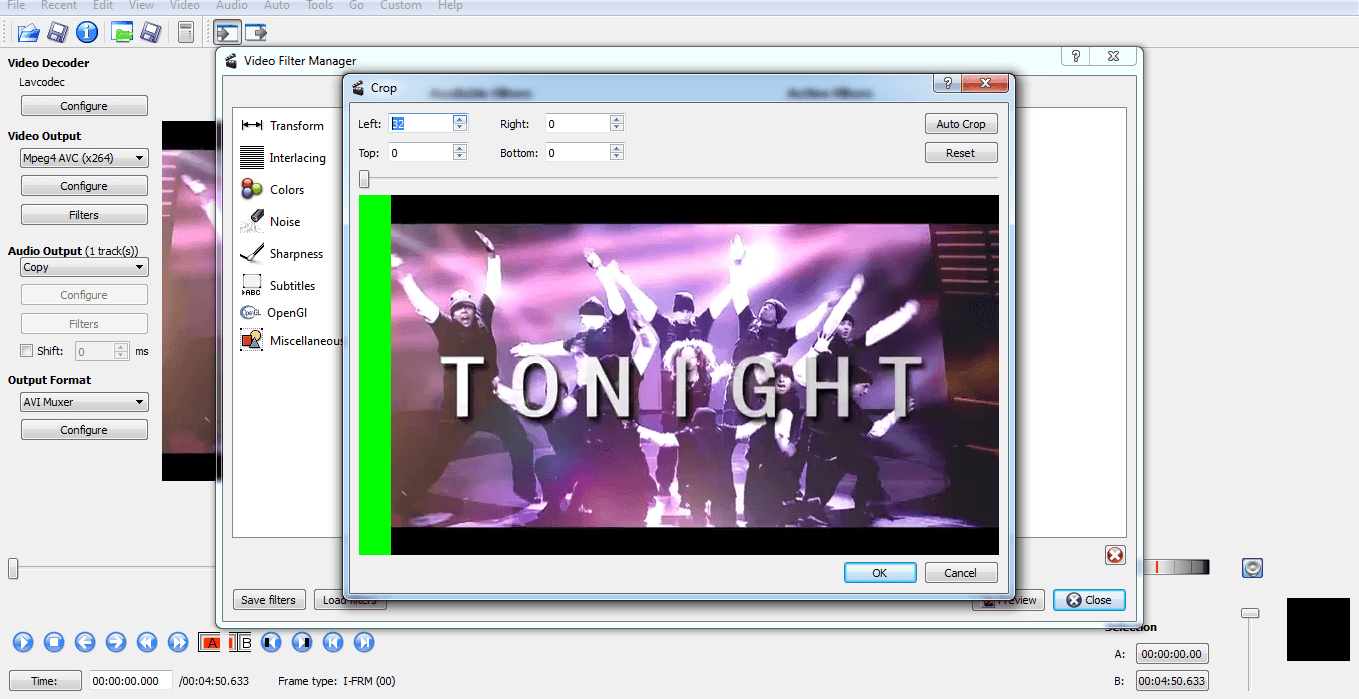
You can adjust this independently for all 4 edges as you wish.
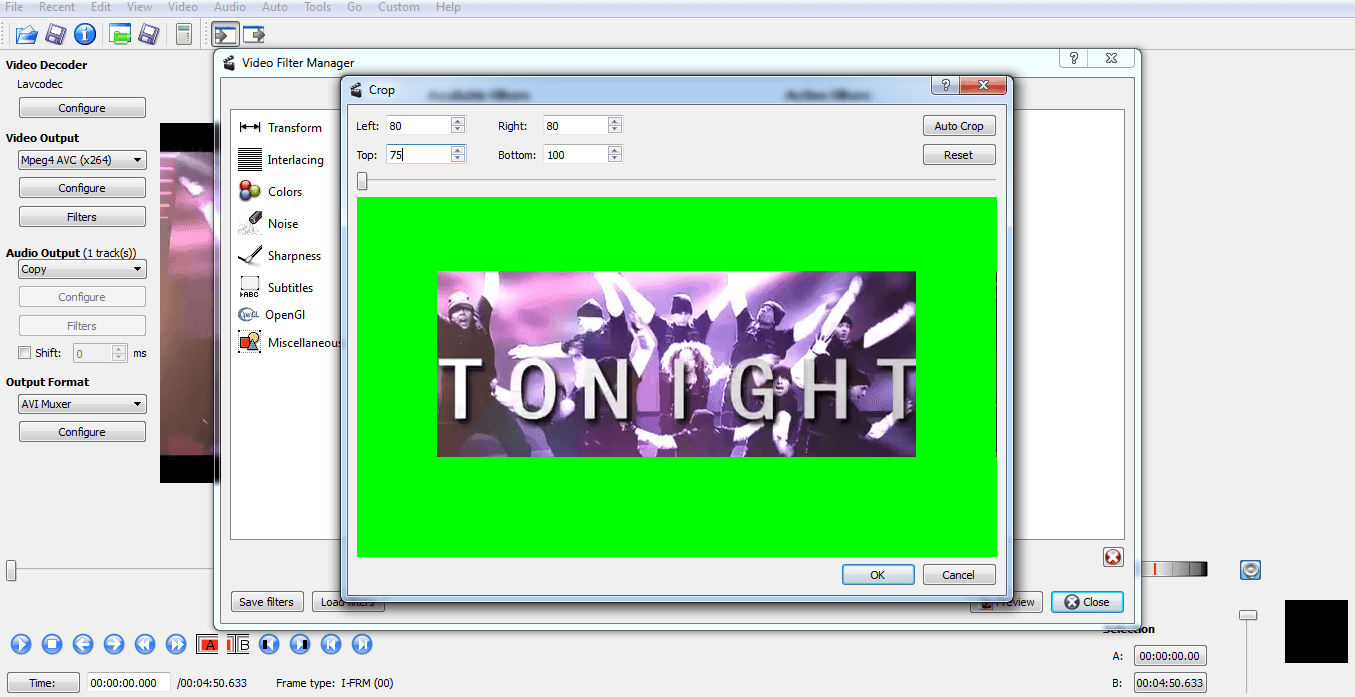
Once you are happy with the crop, you click Ok and it takes you back to the familiar filter menu where you can use other components to perform more editing if you need.
6. Saving the crop
One of the most common points of confusion with Avidemux comes at this point, as your video will look no different to when you started, and many think they have done something wrong, but this is another part of Avidemux workflow. These filters can only be applied when the video is reencoded, and you do that through the file>save menu.

Selecting this presents the familiar export dialogue and allows you to choose the name and destination of the file. Once that is done you click OK and you will see Avidemux processing your file and re-rendering it in this dialogue box.
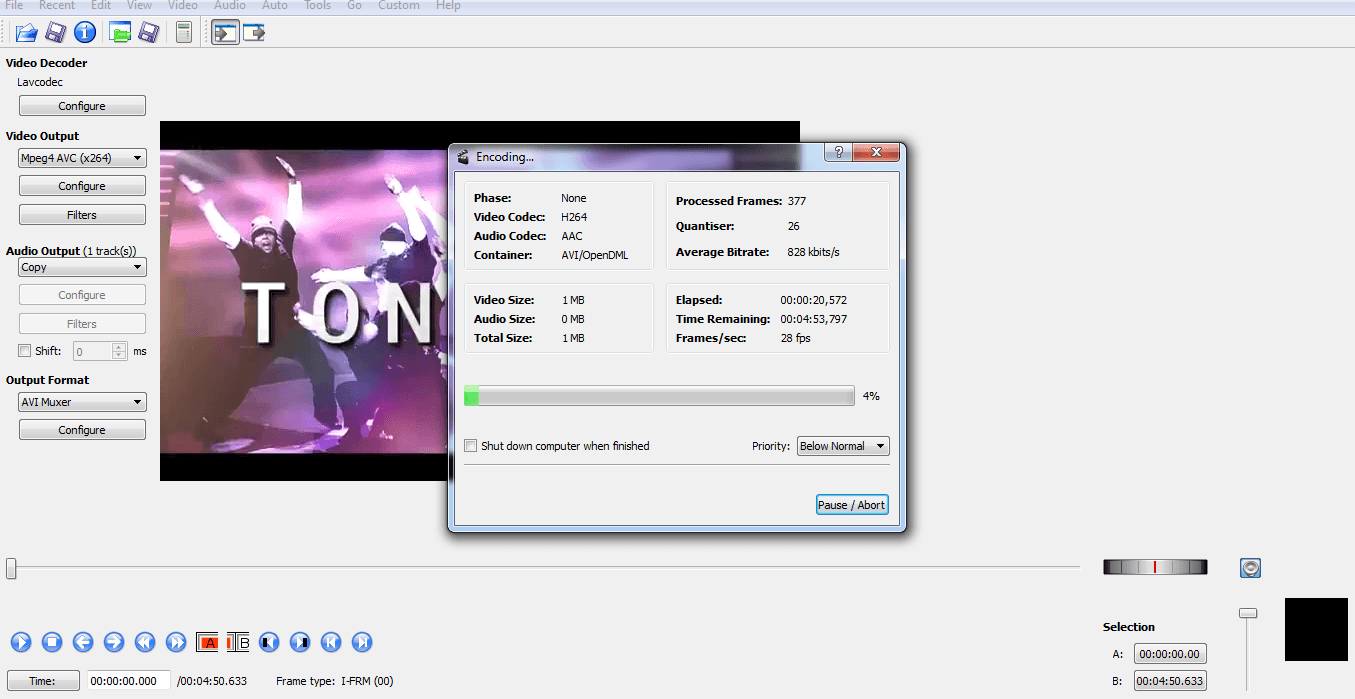
How long it takes will depend on a few factors, how many other effects have been added, how fast a processor your computer has, and how large and what resolution the video is. Format also plays a part in the process too, with some formats taking less time to encode than others. Once it has finished, you can view your video and see the crop in action.
As we can see, although there are a few aspects of the workflow that are a little unintuitive, cropping video in Avidemux is a straightforward process that anyone can accomplish with a bit of patience.
One of the key things to remember with Avidemux is that you apply all of your filters before re-encoding, this again is a question of patience and a bit of organization to ensure everything you wish to do is completed in order.
Avidemux is a great piece of software, it lacks the polish of some of its commercial rivals of course, but behind the sometimes clunky interface there is a very broad range of features that allow you to accomplish more or less any editing task you may want. In terms of free programs this is about as good as it gets, and the output is, without a doubt, great quality. For anyone looking for a free solution to video editing problems, and who do not mind a learning process Avidemux provides a useful tool.
An Easier Way to Crop a Video with Filmora
Filmora Video Editor is a powerful program that allows you to create stunning video clips in only a few clicks. This video editing software provides users with a variety of tools for editing videos. It also includes a user-friendly interface for editing home films on Windows PCs, Macs, and Linux devices. To crop a video, these are to follow:
Step 1: Open a video that you want to edit. Go to “Import” and choose the file that you want to upload and put it in the Media Library.
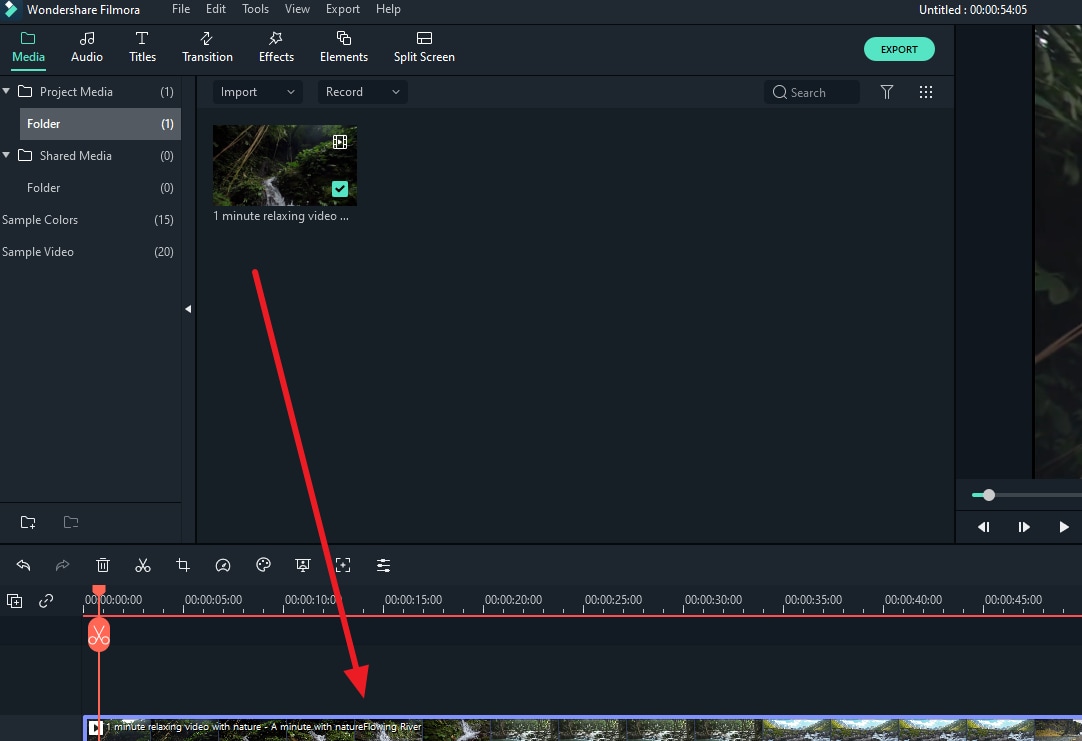
Step 2: Select the “Crop and Zoom” icon in the Filmora editing tool.
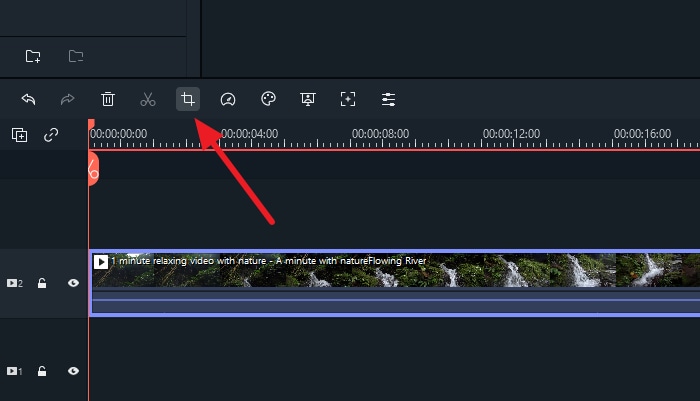
Step 3: To alter the size of the crop frame, drag the pointer from any corner of your video preview window.
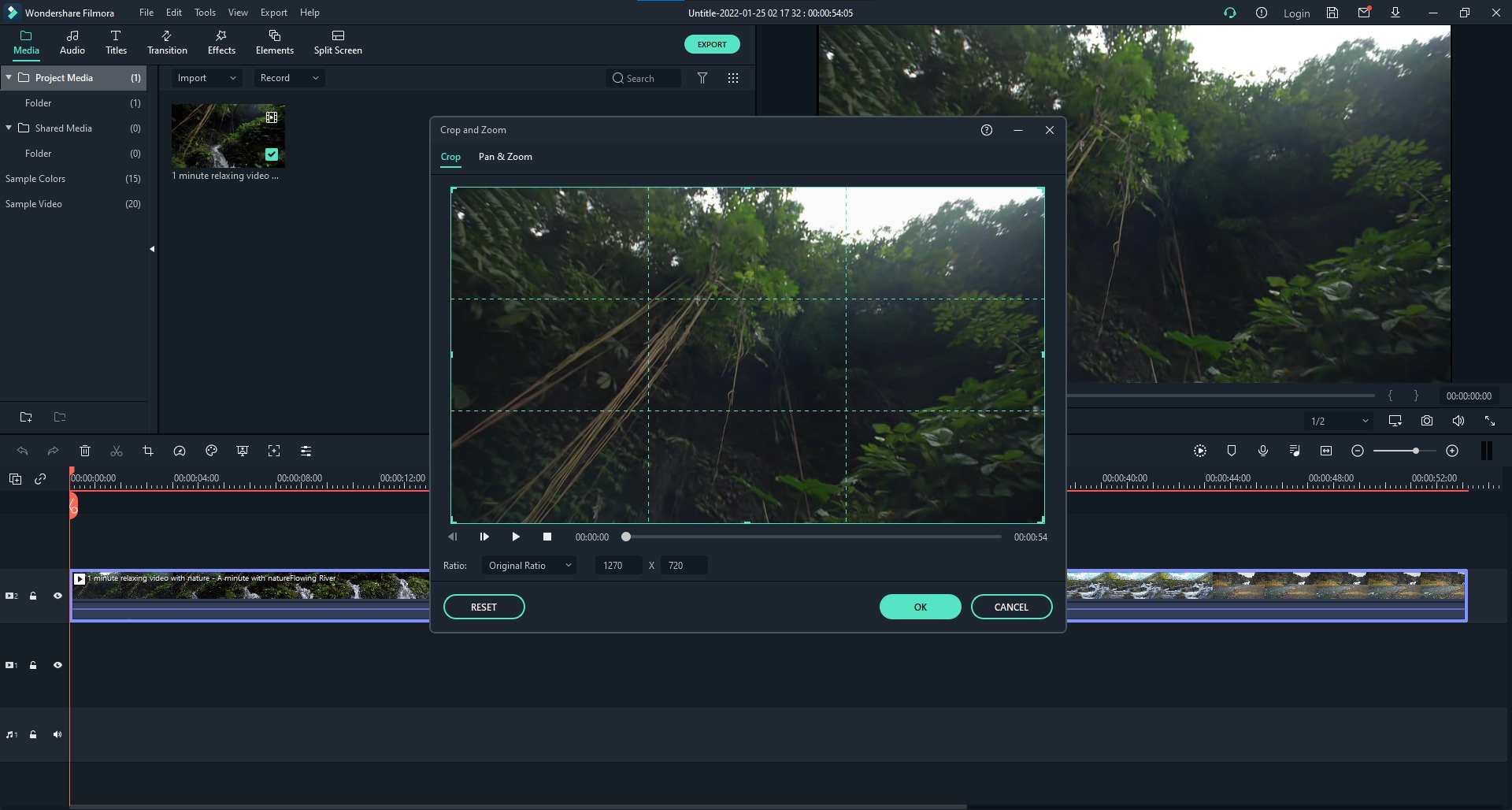
Step 4: When you’ve changed it to your liking, click the green “OK” button. As a result, you may effortlessly add or remove any element of a video clip on Filmora.


Ollie Mattison
Ollie Mattison is a writer and a lover of all things video.
Follow @Ollie Mattison
Ollie Mattison
Mar 27, 2024• Proven solutions
Cropping a video, to bring focus onto the important aspects and remove the extraneous parts of the scene, is one of the most valuable tools available to a video editor. It can be used as mentioned to ensure the viewer focuses on what is important, but also to magnify objects on the screen, such as with footage of nature. It has many uses, and one of the best tools available for cropping video is the free program Avidemux. Here we are going to go through the process of getting Avidemux running on your system and cropping some video.
If Avidemux is too complicate for you, you can consider Wondershare Filmora , which is an easy-to-use video editing tool to crop videos within several click. Download the free trial version blow.
 Download Mac Version ](https://tools.techidaily.com/wondershare/filmora/download/ )
Download Mac Version ](https://tools.techidaily.com/wondershare/filmora/download/ )
How to Crop a Video with Avidemux
1. Installation
You can find Avidemux for download here , it is available for a wide range of platforms, just download the version that fits your needs. Once downloaded, install in the standard way for your platform, this is the Wndows version (64bit).
One point of note during installation is that you can choose which parts of the program you wish to install. It is a very small footprint and for the best performance it is wise to simply install everything.

Once installed you will be presented with the program as seen here.

2. Importing Video
The next step is importing video. This can be done in two ways, by clicking the file folder icon at the top left you open a standard file browser to navigate to, and select your chosen video file, or alternatively you can simply drag you video into the main panel to import it.

Whichever route you take, you will end up with your video file loaded in like this.

Now you can edit the video as you need, Avidemux contains a wealth of features to enable the full spectrum of editing tasks to be completed. However, here we are going to look at the cropping tool, so on to the next step.
3. Editing Video
Avidemux has some idiosyncrasies in terms of operation, one of those is that to be able to edit any video, you have to choose your output format. Don’t worry though, this is easy, just use the dropdown at the side to choose the output format you want as can be seen here.

Once that is set you are free to start editing your footage.
4. Cropping
It is important to understand how the editing process works in Avidemux, everything is accessed via the filters menu Video>Filters and from here you are faced with a new interface that enables you to choose the component you wish to use.

Selecting ‘Crop’ from the menu and pressing the green plus symbol at the bottom activated the crop tool and presents you with yet another view that allows you to adjust the crop to your tastes.

5. Cropping controls
There are two options for cropping, you can use the Auto crop feature, which will detect any black lines and crop the footage between them, or if you are using the crop tool for something else, or just want to do it manually, you can set the crop via the left right top and bottom boxes. Values input here are the number of pixels from that edge the crop extends, as you are setting it, this is displayed with a green block signifying the area of the image that will be removed.

You can adjust this independently for all 4 edges as you wish.

Once you are happy with the crop, you click Ok and it takes you back to the familiar filter menu where you can use other components to perform more editing if you need.
6. Saving the crop
One of the most common points of confusion with Avidemux comes at this point, as your video will look no different to when you started, and many think they have done something wrong, but this is another part of Avidemux workflow. These filters can only be applied when the video is reencoded, and you do that through the file>save menu.

Selecting this presents the familiar export dialogue and allows you to choose the name and destination of the file. Once that is done you click OK and you will see Avidemux processing your file and re-rendering it in this dialogue box.

How long it takes will depend on a few factors, how many other effects have been added, how fast a processor your computer has, and how large and what resolution the video is. Format also plays a part in the process too, with some formats taking less time to encode than others. Once it has finished, you can view your video and see the crop in action.
As we can see, although there are a few aspects of the workflow that are a little unintuitive, cropping video in Avidemux is a straightforward process that anyone can accomplish with a bit of patience.
One of the key things to remember with Avidemux is that you apply all of your filters before re-encoding, this again is a question of patience and a bit of organization to ensure everything you wish to do is completed in order.
Avidemux is a great piece of software, it lacks the polish of some of its commercial rivals of course, but behind the sometimes clunky interface there is a very broad range of features that allow you to accomplish more or less any editing task you may want. In terms of free programs this is about as good as it gets, and the output is, without a doubt, great quality. For anyone looking for a free solution to video editing problems, and who do not mind a learning process Avidemux provides a useful tool.
An Easier Way to Crop a Video with Filmora
Filmora Video Editor is a powerful program that allows you to create stunning video clips in only a few clicks. This video editing software provides users with a variety of tools for editing videos. It also includes a user-friendly interface for editing home films on Windows PCs, Macs, and Linux devices. To crop a video, these are to follow:
Step 1: Open a video that you want to edit. Go to “Import” and choose the file that you want to upload and put it in the Media Library.

Step 2: Select the “Crop and Zoom” icon in the Filmora editing tool.

Step 3: To alter the size of the crop frame, drag the pointer from any corner of your video preview window.

Step 4: When you’ve changed it to your liking, click the green “OK” button. As a result, you may effortlessly add or remove any element of a video clip on Filmora.


Ollie Mattison
Ollie Mattison is a writer and a lover of all things video.
Follow @Ollie Mattison
Ollie Mattison
Mar 27, 2024• Proven solutions
Cropping a video, to bring focus onto the important aspects and remove the extraneous parts of the scene, is one of the most valuable tools available to a video editor. It can be used as mentioned to ensure the viewer focuses on what is important, but also to magnify objects on the screen, such as with footage of nature. It has many uses, and one of the best tools available for cropping video is the free program Avidemux. Here we are going to go through the process of getting Avidemux running on your system and cropping some video.
If Avidemux is too complicate for you, you can consider Wondershare Filmora , which is an easy-to-use video editing tool to crop videos within several click. Download the free trial version blow.
 Download Mac Version ](https://tools.techidaily.com/wondershare/filmora/download/ )
Download Mac Version ](https://tools.techidaily.com/wondershare/filmora/download/ )
How to Crop a Video with Avidemux
1. Installation
You can find Avidemux for download here , it is available for a wide range of platforms, just download the version that fits your needs. Once downloaded, install in the standard way for your platform, this is the Wndows version (64bit).
One point of note during installation is that you can choose which parts of the program you wish to install. It is a very small footprint and for the best performance it is wise to simply install everything.

Once installed you will be presented with the program as seen here.

2. Importing Video
The next step is importing video. This can be done in two ways, by clicking the file folder icon at the top left you open a standard file browser to navigate to, and select your chosen video file, or alternatively you can simply drag you video into the main panel to import it.

Whichever route you take, you will end up with your video file loaded in like this.

Now you can edit the video as you need, Avidemux contains a wealth of features to enable the full spectrum of editing tasks to be completed. However, here we are going to look at the cropping tool, so on to the next step.
3. Editing Video
Avidemux has some idiosyncrasies in terms of operation, one of those is that to be able to edit any video, you have to choose your output format. Don’t worry though, this is easy, just use the dropdown at the side to choose the output format you want as can be seen here.

Once that is set you are free to start editing your footage.
4. Cropping
It is important to understand how the editing process works in Avidemux, everything is accessed via the filters menu Video>Filters and from here you are faced with a new interface that enables you to choose the component you wish to use.

Selecting ‘Crop’ from the menu and pressing the green plus symbol at the bottom activated the crop tool and presents you with yet another view that allows you to adjust the crop to your tastes.

5. Cropping controls
There are two options for cropping, you can use the Auto crop feature, which will detect any black lines and crop the footage between them, or if you are using the crop tool for something else, or just want to do it manually, you can set the crop via the left right top and bottom boxes. Values input here are the number of pixels from that edge the crop extends, as you are setting it, this is displayed with a green block signifying the area of the image that will be removed.

You can adjust this independently for all 4 edges as you wish.

Once you are happy with the crop, you click Ok and it takes you back to the familiar filter menu where you can use other components to perform more editing if you need.
6. Saving the crop
One of the most common points of confusion with Avidemux comes at this point, as your video will look no different to when you started, and many think they have done something wrong, but this is another part of Avidemux workflow. These filters can only be applied when the video is reencoded, and you do that through the file>save menu.

Selecting this presents the familiar export dialogue and allows you to choose the name and destination of the file. Once that is done you click OK and you will see Avidemux processing your file and re-rendering it in this dialogue box.

How long it takes will depend on a few factors, how many other effects have been added, how fast a processor your computer has, and how large and what resolution the video is. Format also plays a part in the process too, with some formats taking less time to encode than others. Once it has finished, you can view your video and see the crop in action.
As we can see, although there are a few aspects of the workflow that are a little unintuitive, cropping video in Avidemux is a straightforward process that anyone can accomplish with a bit of patience.
One of the key things to remember with Avidemux is that you apply all of your filters before re-encoding, this again is a question of patience and a bit of organization to ensure everything you wish to do is completed in order.
Avidemux is a great piece of software, it lacks the polish of some of its commercial rivals of course, but behind the sometimes clunky interface there is a very broad range of features that allow you to accomplish more or less any editing task you may want. In terms of free programs this is about as good as it gets, and the output is, without a doubt, great quality. For anyone looking for a free solution to video editing problems, and who do not mind a learning process Avidemux provides a useful tool.
An Easier Way to Crop a Video with Filmora
Filmora Video Editor is a powerful program that allows you to create stunning video clips in only a few clicks. This video editing software provides users with a variety of tools for editing videos. It also includes a user-friendly interface for editing home films on Windows PCs, Macs, and Linux devices. To crop a video, these are to follow:
Step 1: Open a video that you want to edit. Go to “Import” and choose the file that you want to upload and put it in the Media Library.

Step 2: Select the “Crop and Zoom” icon in the Filmora editing tool.

Step 3: To alter the size of the crop frame, drag the pointer from any corner of your video preview window.

Step 4: When you’ve changed it to your liking, click the green “OK” button. As a result, you may effortlessly add or remove any element of a video clip on Filmora.


Ollie Mattison
Ollie Mattison is a writer and a lover of all things video.
Follow @Ollie Mattison
Ollie Mattison
Mar 27, 2024• Proven solutions
Cropping a video, to bring focus onto the important aspects and remove the extraneous parts of the scene, is one of the most valuable tools available to a video editor. It can be used as mentioned to ensure the viewer focuses on what is important, but also to magnify objects on the screen, such as with footage of nature. It has many uses, and one of the best tools available for cropping video is the free program Avidemux. Here we are going to go through the process of getting Avidemux running on your system and cropping some video.
If Avidemux is too complicate for you, you can consider Wondershare Filmora , which is an easy-to-use video editing tool to crop videos within several click. Download the free trial version blow.
 Download Mac Version ](https://tools.techidaily.com/wondershare/filmora/download/ )
Download Mac Version ](https://tools.techidaily.com/wondershare/filmora/download/ )
How to Crop a Video with Avidemux
1. Installation
You can find Avidemux for download here , it is available for a wide range of platforms, just download the version that fits your needs. Once downloaded, install in the standard way for your platform, this is the Wndows version (64bit).
One point of note during installation is that you can choose which parts of the program you wish to install. It is a very small footprint and for the best performance it is wise to simply install everything.

Once installed you will be presented with the program as seen here.

2. Importing Video
The next step is importing video. This can be done in two ways, by clicking the file folder icon at the top left you open a standard file browser to navigate to, and select your chosen video file, or alternatively you can simply drag you video into the main panel to import it.

Whichever route you take, you will end up with your video file loaded in like this.

Now you can edit the video as you need, Avidemux contains a wealth of features to enable the full spectrum of editing tasks to be completed. However, here we are going to look at the cropping tool, so on to the next step.
3. Editing Video
Avidemux has some idiosyncrasies in terms of operation, one of those is that to be able to edit any video, you have to choose your output format. Don’t worry though, this is easy, just use the dropdown at the side to choose the output format you want as can be seen here.

Once that is set you are free to start editing your footage.
4. Cropping
It is important to understand how the editing process works in Avidemux, everything is accessed via the filters menu Video>Filters and from here you are faced with a new interface that enables you to choose the component you wish to use.

Selecting ‘Crop’ from the menu and pressing the green plus symbol at the bottom activated the crop tool and presents you with yet another view that allows you to adjust the crop to your tastes.

5. Cropping controls
There are two options for cropping, you can use the Auto crop feature, which will detect any black lines and crop the footage between them, or if you are using the crop tool for something else, or just want to do it manually, you can set the crop via the left right top and bottom boxes. Values input here are the number of pixels from that edge the crop extends, as you are setting it, this is displayed with a green block signifying the area of the image that will be removed.

You can adjust this independently for all 4 edges as you wish.

Once you are happy with the crop, you click Ok and it takes you back to the familiar filter menu where you can use other components to perform more editing if you need.
6. Saving the crop
One of the most common points of confusion with Avidemux comes at this point, as your video will look no different to when you started, and many think they have done something wrong, but this is another part of Avidemux workflow. These filters can only be applied when the video is reencoded, and you do that through the file>save menu.

Selecting this presents the familiar export dialogue and allows you to choose the name and destination of the file. Once that is done you click OK and you will see Avidemux processing your file and re-rendering it in this dialogue box.

How long it takes will depend on a few factors, how many other effects have been added, how fast a processor your computer has, and how large and what resolution the video is. Format also plays a part in the process too, with some formats taking less time to encode than others. Once it has finished, you can view your video and see the crop in action.
As we can see, although there are a few aspects of the workflow that are a little unintuitive, cropping video in Avidemux is a straightforward process that anyone can accomplish with a bit of patience.
One of the key things to remember with Avidemux is that you apply all of your filters before re-encoding, this again is a question of patience and a bit of organization to ensure everything you wish to do is completed in order.
Avidemux is a great piece of software, it lacks the polish of some of its commercial rivals of course, but behind the sometimes clunky interface there is a very broad range of features that allow you to accomplish more or less any editing task you may want. In terms of free programs this is about as good as it gets, and the output is, without a doubt, great quality. For anyone looking for a free solution to video editing problems, and who do not mind a learning process Avidemux provides a useful tool.
An Easier Way to Crop a Video with Filmora
Filmora Video Editor is a powerful program that allows you to create stunning video clips in only a few clicks. This video editing software provides users with a variety of tools for editing videos. It also includes a user-friendly interface for editing home films on Windows PCs, Macs, and Linux devices. To crop a video, these are to follow:
Step 1: Open a video that you want to edit. Go to “Import” and choose the file that you want to upload and put it in the Media Library.

Step 2: Select the “Crop and Zoom” icon in the Filmora editing tool.

Step 3: To alter the size of the crop frame, drag the pointer from any corner of your video preview window.

Step 4: When you’ve changed it to your liking, click the green “OK” button. As a result, you may effortlessly add or remove any element of a video clip on Filmora.


Ollie Mattison
Ollie Mattison is a writer and a lover of all things video.
Follow @Ollie Mattison
Free Video Editing on Ubuntu: The Top 10 Options You Should Know
Ubuntu is well-suited to the multidimensional world, not only in terms of playing music and video but also in creating these materials. Nowadays, Ubuntu allows us to professionally make audio and video files. And the best part is that we can do it at no cost.
Here we’ll talk about some free video editors that we may download and install on Ubuntu in this example. It provides the opportunity to create professional videos and even a way of life, like with YouTubers. But to make it easier to choose among so many apps today, we have shortlisted 10 Ubuntu Video Editor.
AI Video Editor A simple video editor that empowers you to edit video and audio on Windows, Mac, iPhone & Android.
![]() Note: Filmora’s online version is upcoming this October! Stay tuned!
Note: Filmora’s online version is upcoming this October! Stay tuned!
Top 10 Best Free Video Editors for Ubuntu
Picking the right video editor might be difficult for some people, but that’s where FOSS Ubuntu comes in. We’ve gathered a list of the finest video editors for Ubuntu for your benefit. We have tried and tested these apps. And based on our experience, we recomend:
| 1 - OpenShot | 2 - OBS Studio | 3 - PiTiVi | 4 - Kdenlive |
|---|---|---|---|
| 5 - Shotcut | 6 - Lightworks | 7 - HitFilm Express | 8 - VLC |
| 9 - Cinelerra | 10 - Blender |
1. OpenShot
We are confident that you will not find a more user-friendly video editor than this one. OpenShot is most likely the best choice when you’re new to video production. It is simple to use, but it also has several interesting features.
This editor comes with a plethora of titles and transitions and compatibility for the majority of video and picture formats. You also receive an excellent export option that allows you to save files in various formats. As already mentioned, the application is designed to meet the needs of beginning learners; yet, advanced users will not be dissatisfied because it supports high-quality video formats such as 4K.
OpenShot has several useful audio editing capabilities, including seeing waveforms on the timeline and even displaying the waveform as part of the film. It also allows you to separate the sound from the video clip and tune each sound channel separately.
2. OBS Studio
OBS Studio is a free, open-source tool that can be downloaded and installed on Ubuntu and other operating systems such as Windows and Mac. Because it includes a fantastic screen capturer , OBS Studio is becoming famous for making videos of Ubuntu or other computer programs. OBS Studio is a basic video editor that lets us blend photos, movies, and music easily.
OBS Studio can create movies in the following formats: Flv, Mkv, mp4, mov, ts, and m3u8. Although the formats are not very open, they are compatible with internet video publishing sites. This editor allows us to modify video rather than merely broadcast it, albeit the editing functionality is not as robust as Kdenlive or Openshot.
OBS Studio also links with video streaming sites to create live videos, unlike other video editing software. This has made it a highly popular software among YouTubers and one that we can download on any Ubuntu version.
3. PiTiVi
Like many others, this one lets you perform basic video editing activities such as trimming, cutting, snapping, splitting, and mixing. The program also supports several additional languages for those who aren’t fluent in English. You should probably read the manual before using it since it contains a lot of valuable information on using this application.
In a word, the application provides a touch-capable, hardware-accelerated user experience. Limitless video/audio track layers, full undo/redo history, trimming, cutting, sound editing of several concurrent audio layers upon layer, volume keyframe curves, keyframe audio enhancements, and more are all supported.
Pitivi creates thumbnails and waveforms in the background to provide you with the best performance without interfering with your workflow. Pitivi may be found in most Ubuntu software repositories. If you want, you may also download pre-assembled kits.

Filmora Free Video Editor
Filmora - No Watermark Video Editing Software
• Easily edit and export video files without watermark
• offers popular effects and filters for making your video professional
• Cross-platform supported - (Windows, Mac, iOS, Android)
Free Video Editing Free Video Editing Learn More >
4. Kdenlive
Kdenlive is, without a doubt, one of the best video editing applications for Ubuntu available right now! What sets it apart from other video editors is that it is completely free and includes several useful features. The MLT Framework, which is based on many other open-source projects, handles most of the video editing in Kdenlive, built on Qt and the KDE Frameworks libraries.
Adjustable layout compatibility, a clip list, a multitrack chronology, automatic backup, keyframe special effects, and transitioning are all included in this video editing program. Do you have a special file format or camcorder? Not an issue — Kdenlive works with practically anything.
It’s also worth noting that Kdenlive runs on Mac OSX and FreeBSD. Proxy editing is another useful function. This handy function can produce low-quality duplicates of your source clips for quick editing and render them in full resolution.
5. Shotcut
Another free, open-source, and cross-platform video editor is Shotcut. Unlike Kdenlive, beginner video editors would obtain a comprehensive understanding of Shotcut because of its user-friendly interface. It has indigenous timeline editing, video transitions and filters, and a multitrack timeline, among other things.
Keyframes for digital filters and 3-point editing are supported. Shotcut is useful if you need to remove the audio from a video clip rapidly. Additionally, it allows you to edit audio and 4K films. Furthermore, it allows for external monitoring.
JACK transport sync, audio blending throughout all channels, stereo, mono, and 5.1 surround sound capabilities are supported on the audio front. Shotcut is considered ideal for beginners, and if you are one, we would highly suggest getting this one for your Ubuntu.
6. Lightworks
Because the functions go beyond the world of inexperienced editors, this video editor for Ubuntu computers is suited for specialists in video editing. The award-winning non-linear editing (NLE) program can handle 4K, Blu-Ray, and even SD and HD footage. You’ll also discover Low-Res Proxy workflows for 4K and drag-and-drop support alongside those capabilities.
Create AI-Generated Video with Filmora
Filmora Free video editor offers a ChatGPT plug-in and AI tools to enhance your creative vision. Make your idea into reality
Edit Video with AI Edit Video with AI
It features voice-over and just added Mackie MIDI compatibility for Ubuntu users. Lightworks supports the most analog and digital connectors, namely 12G, 3G-SDI, Optical audio, HDMI 2, and AES/EBU connectors. The creators have also included professional-level video editing tools and audio filters and enhancements.
7. HitFilm Express
Check out HitFilm Express from FXhome when you seek the greatest video editing software but don’t want to spend a lot of money. This free video editor offers most of the same capabilities as top-tier production suites, featuring 4K video capability, 360-degree editing, and hundreds of special effects.
In reality, when it comes to editing capabilities, Hitfilm Express is extremely similar to Adobe Premiere Pro.
The major disadvantage of this program is that it consumes a lot of system resources, which means it won’t run on many lightweight laptops. You’ll have to pay extra for things like 360-degree text, extra color grading facilities, and other aesthetic enhancements, among other things. Hitfilm Express is a video editor that is so strong and simple to use that it’s difficult to believe it’s free. It’s a great option for any video creator on a shoestring budget.
8. VLC
VLC Media Player has become one of the most widely used media players . It’s not only simple to use, but it also supports a variety of file types without requiring any further purchases or downloads.
It may be used to optimize audio and video on your device of choice. It can play DivC and MPEG streams. You may also watch videos as they’re downloading. It has a basic and easy user interface.
It can be used to start or join a video broadcast. VLC may be controlled via shortcut keys. Some options can be tweaked to suit your tastes. You don’t need to download any codecs to read music or video files. It includes an equalizer built-in that allows users to increase sound quality without altering it.
Finding a Way to Export Edited Video with No Watermark? Try This Out!
Filmora Video Editor brings you all the convenience of editing videos with handy functions. You can make your creative ideas into realize! More importantly, your edited video can export without a watermark!
Try It Free Try It Free Learn More >
9. Cinelerra
Cinelerra is a video editor for GNU/Ubuntu, first released in 1998. It was the first non-linear video editor for GNU/Ubuntu that was functional with 64-bit platforms. Cinelerra was a huge hit in its early years since it was a comprehensive and free video editor that was practically unique in its field. However, as time went on, progress slowed, and many users abandoned the project.
Currently, work is ongoing, and new Ubuntu versions are being released in stages. Cinelerra includes a split editing panel that, like Gimp, allows for non-linear video editing. Like all other video editors, Cinelerra provides a variety of video effects and transitions for producing movies and slideshows. We can get Cinelerra from Sourceforge; once we install it, we should run the program using the./ command.
10. Blender
Like Lightworks and KDenlive, this video editor is geared towards advanced users, but the greatest part is that it is free. It focuses on 3D animation rather than traditional video editing. It’s widely used in 3D modeling, visual effects, animation, simulation, pipeline, and game development.
Blender has filters, transitions, keyframes , adjustment layers, speed control, live preview, histogram displays, luma waveform, and chroma vectorscope for video production. Aside from that, it also allows you to mix, sync, and scrub audio files.
Because all of these functions might be a steep learning curve, it is a little challenging for inexperienced video producers. It is, without a doubt, the finest example of a free and open-source community project. Blender is a free program found in practically any software app store.
Conclusion
Well, there you have it – your best Ubuntu Video Editor tools list. Using Ubuntu does not preclude you from installing high-quality apps. Except for the video editors described above, there are many other Ubuntu applications available.
A few are geared for pros (such as Lightworks, HitFilm Express, and Blender), while others are designed for beginners (similar to Shotcut and OpenShot). Additionally, because most video editors are currently accessible on the google play store, you would be able to download and install them on your Ubuntu laptop.
![]() Note: Filmora’s online version is upcoming this October! Stay tuned!
Note: Filmora’s online version is upcoming this October! Stay tuned!
Top 10 Best Free Video Editors for Ubuntu
Picking the right video editor might be difficult for some people, but that’s where FOSS Ubuntu comes in. We’ve gathered a list of the finest video editors for Ubuntu for your benefit. We have tried and tested these apps. And based on our experience, we recomend:
| 1 - OpenShot | 2 - OBS Studio | 3 - PiTiVi | 4 - Kdenlive |
|---|---|---|---|
| 5 - Shotcut | 6 - Lightworks | 7 - HitFilm Express | 8 - VLC |
| 9 - Cinelerra | 10 - Blender |
1. OpenShot
We are confident that you will not find a more user-friendly video editor than this one. OpenShot is most likely the best choice when you’re new to video production. It is simple to use, but it also has several interesting features.
This editor comes with a plethora of titles and transitions and compatibility for the majority of video and picture formats. You also receive an excellent export option that allows you to save files in various formats. As already mentioned, the application is designed to meet the needs of beginning learners; yet, advanced users will not be dissatisfied because it supports high-quality video formats such as 4K.
OpenShot has several useful audio editing capabilities, including seeing waveforms on the timeline and even displaying the waveform as part of the film. It also allows you to separate the sound from the video clip and tune each sound channel separately.
2. OBS Studio
OBS Studio is a free, open-source tool that can be downloaded and installed on Ubuntu and other operating systems such as Windows and Mac. Because it includes a fantastic screen capturer , OBS Studio is becoming famous for making videos of Ubuntu or other computer programs. OBS Studio is a basic video editor that lets us blend photos, movies, and music easily.
OBS Studio can create movies in the following formats: Flv, Mkv, mp4, mov, ts, and m3u8. Although the formats are not very open, they are compatible with internet video publishing sites. This editor allows us to modify video rather than merely broadcast it, albeit the editing functionality is not as robust as Kdenlive or Openshot.
OBS Studio also links with video streaming sites to create live videos, unlike other video editing software. This has made it a highly popular software among YouTubers and one that we can download on any Ubuntu version.
3. PiTiVi
Like many others, this one lets you perform basic video editing activities such as trimming, cutting, snapping, splitting, and mixing. The program also supports several additional languages for those who aren’t fluent in English. You should probably read the manual before using it since it contains a lot of valuable information on using this application.
In a word, the application provides a touch-capable, hardware-accelerated user experience. Limitless video/audio track layers, full undo/redo history, trimming, cutting, sound editing of several concurrent audio layers upon layer, volume keyframe curves, keyframe audio enhancements, and more are all supported.
Pitivi creates thumbnails and waveforms in the background to provide you with the best performance without interfering with your workflow. Pitivi may be found in most Ubuntu software repositories. If you want, you may also download pre-assembled kits.

Filmora Free Video Editor
Filmora - No Watermark Video Editing Software
• Easily edit and export video files without watermark
• offers popular effects and filters for making your video professional
• Cross-platform supported - (Windows, Mac, iOS, Android)
Free Video Editing Free Video Editing Learn More >
4. Kdenlive
Kdenlive is, without a doubt, one of the best video editing applications for Ubuntu available right now! What sets it apart from other video editors is that it is completely free and includes several useful features. The MLT Framework, which is based on many other open-source projects, handles most of the video editing in Kdenlive, built on Qt and the KDE Frameworks libraries.
Adjustable layout compatibility, a clip list, a multitrack chronology, automatic backup, keyframe special effects, and transitioning are all included in this video editing program. Do you have a special file format or camcorder? Not an issue — Kdenlive works with practically anything.
It’s also worth noting that Kdenlive runs on Mac OSX and FreeBSD. Proxy editing is another useful function. This handy function can produce low-quality duplicates of your source clips for quick editing and render them in full resolution.
5. Shotcut
Another free, open-source, and cross-platform video editor is Shotcut. Unlike Kdenlive, beginner video editors would obtain a comprehensive understanding of Shotcut because of its user-friendly interface. It has indigenous timeline editing, video transitions and filters, and a multitrack timeline, among other things.
Keyframes for digital filters and 3-point editing are supported. Shotcut is useful if you need to remove the audio from a video clip rapidly. Additionally, it allows you to edit audio and 4K films. Furthermore, it allows for external monitoring.
JACK transport sync, audio blending throughout all channels, stereo, mono, and 5.1 surround sound capabilities are supported on the audio front. Shotcut is considered ideal for beginners, and if you are one, we would highly suggest getting this one for your Ubuntu.
6. Lightworks
Because the functions go beyond the world of inexperienced editors, this video editor for Ubuntu computers is suited for specialists in video editing. The award-winning non-linear editing (NLE) program can handle 4K, Blu-Ray, and even SD and HD footage. You’ll also discover Low-Res Proxy workflows for 4K and drag-and-drop support alongside those capabilities.
Create AI-Generated Video with Filmora
Filmora Free video editor offers a ChatGPT plug-in and AI tools to enhance your creative vision. Make your idea into reality
Edit Video with AI Edit Video with AI
It features voice-over and just added Mackie MIDI compatibility for Ubuntu users. Lightworks supports the most analog and digital connectors, namely 12G, 3G-SDI, Optical audio, HDMI 2, and AES/EBU connectors. The creators have also included professional-level video editing tools and audio filters and enhancements.
7. HitFilm Express
Check out HitFilm Express from FXhome when you seek the greatest video editing software but don’t want to spend a lot of money. This free video editor offers most of the same capabilities as top-tier production suites, featuring 4K video capability, 360-degree editing, and hundreds of special effects.
In reality, when it comes to editing capabilities, Hitfilm Express is extremely similar to Adobe Premiere Pro.
The major disadvantage of this program is that it consumes a lot of system resources, which means it won’t run on many lightweight laptops. You’ll have to pay extra for things like 360-degree text, extra color grading facilities, and other aesthetic enhancements, among other things. Hitfilm Express is a video editor that is so strong and simple to use that it’s difficult to believe it’s free. It’s a great option for any video creator on a shoestring budget.
8. VLC
VLC Media Player has become one of the most widely used media players . It’s not only simple to use, but it also supports a variety of file types without requiring any further purchases or downloads.
It may be used to optimize audio and video on your device of choice. It can play DivC and MPEG streams. You may also watch videos as they’re downloading. It has a basic and easy user interface.
It can be used to start or join a video broadcast. VLC may be controlled via shortcut keys. Some options can be tweaked to suit your tastes. You don’t need to download any codecs to read music or video files. It includes an equalizer built-in that allows users to increase sound quality without altering it.
Finding a Way to Export Edited Video with No Watermark? Try This Out!
Filmora Video Editor brings you all the convenience of editing videos with handy functions. You can make your creative ideas into realize! More importantly, your edited video can export without a watermark!
Try It Free Try It Free Learn More >
9. Cinelerra
Cinelerra is a video editor for GNU/Ubuntu, first released in 1998. It was the first non-linear video editor for GNU/Ubuntu that was functional with 64-bit platforms. Cinelerra was a huge hit in its early years since it was a comprehensive and free video editor that was practically unique in its field. However, as time went on, progress slowed, and many users abandoned the project.
Currently, work is ongoing, and new Ubuntu versions are being released in stages. Cinelerra includes a split editing panel that, like Gimp, allows for non-linear video editing. Like all other video editors, Cinelerra provides a variety of video effects and transitions for producing movies and slideshows. We can get Cinelerra from Sourceforge; once we install it, we should run the program using the./ command.
10. Blender
Like Lightworks and KDenlive, this video editor is geared towards advanced users, but the greatest part is that it is free. It focuses on 3D animation rather than traditional video editing. It’s widely used in 3D modeling, visual effects, animation, simulation, pipeline, and game development.
Blender has filters, transitions, keyframes , adjustment layers, speed control, live preview, histogram displays, luma waveform, and chroma vectorscope for video production. Aside from that, it also allows you to mix, sync, and scrub audio files.
Because all of these functions might be a steep learning curve, it is a little challenging for inexperienced video producers. It is, without a doubt, the finest example of a free and open-source community project. Blender is a free program found in practically any software app store.
Conclusion
Well, there you have it – your best Ubuntu Video Editor tools list. Using Ubuntu does not preclude you from installing high-quality apps. Except for the video editors described above, there are many other Ubuntu applications available.
A few are geared for pros (such as Lightworks, HitFilm Express, and Blender), while others are designed for beginners (similar to Shotcut and OpenShot). Additionally, because most video editors are currently accessible on the google play store, you would be able to download and install them on your Ubuntu laptop.
![]() Note: Filmora’s online version is upcoming this October! Stay tuned!
Note: Filmora’s online version is upcoming this October! Stay tuned!
Top 10 Best Free Video Editors for Ubuntu
Picking the right video editor might be difficult for some people, but that’s where FOSS Ubuntu comes in. We’ve gathered a list of the finest video editors for Ubuntu for your benefit. We have tried and tested these apps. And based on our experience, we recomend:
| 1 - OpenShot | 2 - OBS Studio | 3 - PiTiVi | 4 - Kdenlive |
|---|---|---|---|
| 5 - Shotcut | 6 - Lightworks | 7 - HitFilm Express | 8 - VLC |
| 9 - Cinelerra | 10 - Blender |
1. OpenShot
We are confident that you will not find a more user-friendly video editor than this one. OpenShot is most likely the best choice when you’re new to video production. It is simple to use, but it also has several interesting features.
This editor comes with a plethora of titles and transitions and compatibility for the majority of video and picture formats. You also receive an excellent export option that allows you to save files in various formats. As already mentioned, the application is designed to meet the needs of beginning learners; yet, advanced users will not be dissatisfied because it supports high-quality video formats such as 4K.
OpenShot has several useful audio editing capabilities, including seeing waveforms on the timeline and even displaying the waveform as part of the film. It also allows you to separate the sound from the video clip and tune each sound channel separately.
2. OBS Studio
OBS Studio is a free, open-source tool that can be downloaded and installed on Ubuntu and other operating systems such as Windows and Mac. Because it includes a fantastic screen capturer , OBS Studio is becoming famous for making videos of Ubuntu or other computer programs. OBS Studio is a basic video editor that lets us blend photos, movies, and music easily.
OBS Studio can create movies in the following formats: Flv, Mkv, mp4, mov, ts, and m3u8. Although the formats are not very open, they are compatible with internet video publishing sites. This editor allows us to modify video rather than merely broadcast it, albeit the editing functionality is not as robust as Kdenlive or Openshot.
OBS Studio also links with video streaming sites to create live videos, unlike other video editing software. This has made it a highly popular software among YouTubers and one that we can download on any Ubuntu version.
3. PiTiVi
Like many others, this one lets you perform basic video editing activities such as trimming, cutting, snapping, splitting, and mixing. The program also supports several additional languages for those who aren’t fluent in English. You should probably read the manual before using it since it contains a lot of valuable information on using this application.
In a word, the application provides a touch-capable, hardware-accelerated user experience. Limitless video/audio track layers, full undo/redo history, trimming, cutting, sound editing of several concurrent audio layers upon layer, volume keyframe curves, keyframe audio enhancements, and more are all supported.
Pitivi creates thumbnails and waveforms in the background to provide you with the best performance without interfering with your workflow. Pitivi may be found in most Ubuntu software repositories. If you want, you may also download pre-assembled kits.

Filmora Free Video Editor
Filmora - No Watermark Video Editing Software
• Easily edit and export video files without watermark
• offers popular effects and filters for making your video professional
• Cross-platform supported - (Windows, Mac, iOS, Android)
Free Video Editing Free Video Editing Learn More >
4. Kdenlive
Kdenlive is, without a doubt, one of the best video editing applications for Ubuntu available right now! What sets it apart from other video editors is that it is completely free and includes several useful features. The MLT Framework, which is based on many other open-source projects, handles most of the video editing in Kdenlive, built on Qt and the KDE Frameworks libraries.
Adjustable layout compatibility, a clip list, a multitrack chronology, automatic backup, keyframe special effects, and transitioning are all included in this video editing program. Do you have a special file format or camcorder? Not an issue — Kdenlive works with practically anything.
It’s also worth noting that Kdenlive runs on Mac OSX and FreeBSD. Proxy editing is another useful function. This handy function can produce low-quality duplicates of your source clips for quick editing and render them in full resolution.
5. Shotcut
Another free, open-source, and cross-platform video editor is Shotcut. Unlike Kdenlive, beginner video editors would obtain a comprehensive understanding of Shotcut because of its user-friendly interface. It has indigenous timeline editing, video transitions and filters, and a multitrack timeline, among other things.
Keyframes for digital filters and 3-point editing are supported. Shotcut is useful if you need to remove the audio from a video clip rapidly. Additionally, it allows you to edit audio and 4K films. Furthermore, it allows for external monitoring.
JACK transport sync, audio blending throughout all channels, stereo, mono, and 5.1 surround sound capabilities are supported on the audio front. Shotcut is considered ideal for beginners, and if you are one, we would highly suggest getting this one for your Ubuntu.
6. Lightworks
Because the functions go beyond the world of inexperienced editors, this video editor for Ubuntu computers is suited for specialists in video editing. The award-winning non-linear editing (NLE) program can handle 4K, Blu-Ray, and even SD and HD footage. You’ll also discover Low-Res Proxy workflows for 4K and drag-and-drop support alongside those capabilities.
Create AI-Generated Video with Filmora
Filmora Free video editor offers a ChatGPT plug-in and AI tools to enhance your creative vision. Make your idea into reality
Edit Video with AI Edit Video with AI
It features voice-over and just added Mackie MIDI compatibility for Ubuntu users. Lightworks supports the most analog and digital connectors, namely 12G, 3G-SDI, Optical audio, HDMI 2, and AES/EBU connectors. The creators have also included professional-level video editing tools and audio filters and enhancements.
7. HitFilm Express
Check out HitFilm Express from FXhome when you seek the greatest video editing software but don’t want to spend a lot of money. This free video editor offers most of the same capabilities as top-tier production suites, featuring 4K video capability, 360-degree editing, and hundreds of special effects.
In reality, when it comes to editing capabilities, Hitfilm Express is extremely similar to Adobe Premiere Pro.
The major disadvantage of this program is that it consumes a lot of system resources, which means it won’t run on many lightweight laptops. You’ll have to pay extra for things like 360-degree text, extra color grading facilities, and other aesthetic enhancements, among other things. Hitfilm Express is a video editor that is so strong and simple to use that it’s difficult to believe it’s free. It’s a great option for any video creator on a shoestring budget.
8. VLC
VLC Media Player has become one of the most widely used media players . It’s not only simple to use, but it also supports a variety of file types without requiring any further purchases or downloads.
It may be used to optimize audio and video on your device of choice. It can play DivC and MPEG streams. You may also watch videos as they’re downloading. It has a basic and easy user interface.
It can be used to start or join a video broadcast. VLC may be controlled via shortcut keys. Some options can be tweaked to suit your tastes. You don’t need to download any codecs to read music or video files. It includes an equalizer built-in that allows users to increase sound quality without altering it.
Finding a Way to Export Edited Video with No Watermark? Try This Out!
Filmora Video Editor brings you all the convenience of editing videos with handy functions. You can make your creative ideas into realize! More importantly, your edited video can export without a watermark!
Try It Free Try It Free Learn More >
9. Cinelerra
Cinelerra is a video editor for GNU/Ubuntu, first released in 1998. It was the first non-linear video editor for GNU/Ubuntu that was functional with 64-bit platforms. Cinelerra was a huge hit in its early years since it was a comprehensive and free video editor that was practically unique in its field. However, as time went on, progress slowed, and many users abandoned the project.
Currently, work is ongoing, and new Ubuntu versions are being released in stages. Cinelerra includes a split editing panel that, like Gimp, allows for non-linear video editing. Like all other video editors, Cinelerra provides a variety of video effects and transitions for producing movies and slideshows. We can get Cinelerra from Sourceforge; once we install it, we should run the program using the./ command.
10. Blender
Like Lightworks and KDenlive, this video editor is geared towards advanced users, but the greatest part is that it is free. It focuses on 3D animation rather than traditional video editing. It’s widely used in 3D modeling, visual effects, animation, simulation, pipeline, and game development.
Blender has filters, transitions, keyframes , adjustment layers, speed control, live preview, histogram displays, luma waveform, and chroma vectorscope for video production. Aside from that, it also allows you to mix, sync, and scrub audio files.
Because all of these functions might be a steep learning curve, it is a little challenging for inexperienced video producers. It is, without a doubt, the finest example of a free and open-source community project. Blender is a free program found in practically any software app store.
Conclusion
Well, there you have it – your best Ubuntu Video Editor tools list. Using Ubuntu does not preclude you from installing high-quality apps. Except for the video editors described above, there are many other Ubuntu applications available.
A few are geared for pros (such as Lightworks, HitFilm Express, and Blender), while others are designed for beginners (similar to Shotcut and OpenShot). Additionally, because most video editors are currently accessible on the google play store, you would be able to download and install them on your Ubuntu laptop.
![]() Note: Filmora’s online version is upcoming this October! Stay tuned!
Note: Filmora’s online version is upcoming this October! Stay tuned!
Top 10 Best Free Video Editors for Ubuntu
Picking the right video editor might be difficult for some people, but that’s where FOSS Ubuntu comes in. We’ve gathered a list of the finest video editors for Ubuntu for your benefit. We have tried and tested these apps. And based on our experience, we recomend:
| 1 - OpenShot | 2 - OBS Studio | 3 - PiTiVi | 4 - Kdenlive |
|---|---|---|---|
| 5 - Shotcut | 6 - Lightworks | 7 - HitFilm Express | 8 - VLC |
| 9 - Cinelerra | 10 - Blender |
1. OpenShot
We are confident that you will not find a more user-friendly video editor than this one. OpenShot is most likely the best choice when you’re new to video production. It is simple to use, but it also has several interesting features.
This editor comes with a plethora of titles and transitions and compatibility for the majority of video and picture formats. You also receive an excellent export option that allows you to save files in various formats. As already mentioned, the application is designed to meet the needs of beginning learners; yet, advanced users will not be dissatisfied because it supports high-quality video formats such as 4K.
OpenShot has several useful audio editing capabilities, including seeing waveforms on the timeline and even displaying the waveform as part of the film. It also allows you to separate the sound from the video clip and tune each sound channel separately.
2. OBS Studio
OBS Studio is a free, open-source tool that can be downloaded and installed on Ubuntu and other operating systems such as Windows and Mac. Because it includes a fantastic screen capturer , OBS Studio is becoming famous for making videos of Ubuntu or other computer programs. OBS Studio is a basic video editor that lets us blend photos, movies, and music easily.
OBS Studio can create movies in the following formats: Flv, Mkv, mp4, mov, ts, and m3u8. Although the formats are not very open, they are compatible with internet video publishing sites. This editor allows us to modify video rather than merely broadcast it, albeit the editing functionality is not as robust as Kdenlive or Openshot.
OBS Studio also links with video streaming sites to create live videos, unlike other video editing software. This has made it a highly popular software among YouTubers and one that we can download on any Ubuntu version.
3. PiTiVi
Like many others, this one lets you perform basic video editing activities such as trimming, cutting, snapping, splitting, and mixing. The program also supports several additional languages for those who aren’t fluent in English. You should probably read the manual before using it since it contains a lot of valuable information on using this application.
In a word, the application provides a touch-capable, hardware-accelerated user experience. Limitless video/audio track layers, full undo/redo history, trimming, cutting, sound editing of several concurrent audio layers upon layer, volume keyframe curves, keyframe audio enhancements, and more are all supported.
Pitivi creates thumbnails and waveforms in the background to provide you with the best performance without interfering with your workflow. Pitivi may be found in most Ubuntu software repositories. If you want, you may also download pre-assembled kits.

Filmora Free Video Editor
Filmora - No Watermark Video Editing Software
• Easily edit and export video files without watermark
• offers popular effects and filters for making your video professional
• Cross-platform supported - (Windows, Mac, iOS, Android)
Free Video Editing Free Video Editing Learn More >
4. Kdenlive
Kdenlive is, without a doubt, one of the best video editing applications for Ubuntu available right now! What sets it apart from other video editors is that it is completely free and includes several useful features. The MLT Framework, which is based on many other open-source projects, handles most of the video editing in Kdenlive, built on Qt and the KDE Frameworks libraries.
Adjustable layout compatibility, a clip list, a multitrack chronology, automatic backup, keyframe special effects, and transitioning are all included in this video editing program. Do you have a special file format or camcorder? Not an issue — Kdenlive works with practically anything.
It’s also worth noting that Kdenlive runs on Mac OSX and FreeBSD. Proxy editing is another useful function. This handy function can produce low-quality duplicates of your source clips for quick editing and render them in full resolution.
5. Shotcut
Another free, open-source, and cross-platform video editor is Shotcut. Unlike Kdenlive, beginner video editors would obtain a comprehensive understanding of Shotcut because of its user-friendly interface. It has indigenous timeline editing, video transitions and filters, and a multitrack timeline, among other things.
Keyframes for digital filters and 3-point editing are supported. Shotcut is useful if you need to remove the audio from a video clip rapidly. Additionally, it allows you to edit audio and 4K films. Furthermore, it allows for external monitoring.
JACK transport sync, audio blending throughout all channels, stereo, mono, and 5.1 surround sound capabilities are supported on the audio front. Shotcut is considered ideal for beginners, and if you are one, we would highly suggest getting this one for your Ubuntu.
6. Lightworks
Because the functions go beyond the world of inexperienced editors, this video editor for Ubuntu computers is suited for specialists in video editing. The award-winning non-linear editing (NLE) program can handle 4K, Blu-Ray, and even SD and HD footage. You’ll also discover Low-Res Proxy workflows for 4K and drag-and-drop support alongside those capabilities.
Create AI-Generated Video with Filmora
Filmora Free video editor offers a ChatGPT plug-in and AI tools to enhance your creative vision. Make your idea into reality
Edit Video with AI Edit Video with AI
It features voice-over and just added Mackie MIDI compatibility for Ubuntu users. Lightworks supports the most analog and digital connectors, namely 12G, 3G-SDI, Optical audio, HDMI 2, and AES/EBU connectors. The creators have also included professional-level video editing tools and audio filters and enhancements.
7. HitFilm Express
Check out HitFilm Express from FXhome when you seek the greatest video editing software but don’t want to spend a lot of money. This free video editor offers most of the same capabilities as top-tier production suites, featuring 4K video capability, 360-degree editing, and hundreds of special effects.
In reality, when it comes to editing capabilities, Hitfilm Express is extremely similar to Adobe Premiere Pro.
The major disadvantage of this program is that it consumes a lot of system resources, which means it won’t run on many lightweight laptops. You’ll have to pay extra for things like 360-degree text, extra color grading facilities, and other aesthetic enhancements, among other things. Hitfilm Express is a video editor that is so strong and simple to use that it’s difficult to believe it’s free. It’s a great option for any video creator on a shoestring budget.
8. VLC
VLC Media Player has become one of the most widely used media players . It’s not only simple to use, but it also supports a variety of file types without requiring any further purchases or downloads.
It may be used to optimize audio and video on your device of choice. It can play DivC and MPEG streams. You may also watch videos as they’re downloading. It has a basic and easy user interface.
It can be used to start or join a video broadcast. VLC may be controlled via shortcut keys. Some options can be tweaked to suit your tastes. You don’t need to download any codecs to read music or video files. It includes an equalizer built-in that allows users to increase sound quality without altering it.
Finding a Way to Export Edited Video with No Watermark? Try This Out!
Filmora Video Editor brings you all the convenience of editing videos with handy functions. You can make your creative ideas into realize! More importantly, your edited video can export without a watermark!
Try It Free Try It Free Learn More >
9. Cinelerra
Cinelerra is a video editor for GNU/Ubuntu, first released in 1998. It was the first non-linear video editor for GNU/Ubuntu that was functional with 64-bit platforms. Cinelerra was a huge hit in its early years since it was a comprehensive and free video editor that was practically unique in its field. However, as time went on, progress slowed, and many users abandoned the project.
Currently, work is ongoing, and new Ubuntu versions are being released in stages. Cinelerra includes a split editing panel that, like Gimp, allows for non-linear video editing. Like all other video editors, Cinelerra provides a variety of video effects and transitions for producing movies and slideshows. We can get Cinelerra from Sourceforge; once we install it, we should run the program using the./ command.
10. Blender
Like Lightworks and KDenlive, this video editor is geared towards advanced users, but the greatest part is that it is free. It focuses on 3D animation rather than traditional video editing. It’s widely used in 3D modeling, visual effects, animation, simulation, pipeline, and game development.
Blender has filters, transitions, keyframes , adjustment layers, speed control, live preview, histogram displays, luma waveform, and chroma vectorscope for video production. Aside from that, it also allows you to mix, sync, and scrub audio files.
Because all of these functions might be a steep learning curve, it is a little challenging for inexperienced video producers. It is, without a doubt, the finest example of a free and open-source community project. Blender is a free program found in practically any software app store.
Conclusion
Well, there you have it – your best Ubuntu Video Editor tools list. Using Ubuntu does not preclude you from installing high-quality apps. Except for the video editors described above, there are many other Ubuntu applications available.
A few are geared for pros (such as Lightworks, HitFilm Express, and Blender), while others are designed for beginners (similar to Shotcut and OpenShot). Additionally, because most video editors are currently accessible on the google play store, you would be able to download and install them on your Ubuntu laptop.
6 Video Mergers Without Watermark
Sometimes, when delving into the vast space of internet and trying to find the perfect online platforms or software in order to edit some videos, it might get frustrating to find only the ones with watermark. But of course, the resources are endless and in case we have some information, we can easily access the free video editing platforms which give us the opportunity to edit our videos without undesired logos on them. In this case, we will be discussing 6 video mergers without watermark, and the way we can use them – the tools and features they offer, and how we can get the best out of them.
- Photos by Microsoft
If you are too lazy to get high-quality results using popular video editors, like Filmora, try Photos App. It is a built-in program that usually opens your images on Windows 10, but you can also use it for merging your videos. And guess what? Since it comes within the system, all the features, although limited, are absolutely free.
How to Merge Videos on Windows using Photos App?
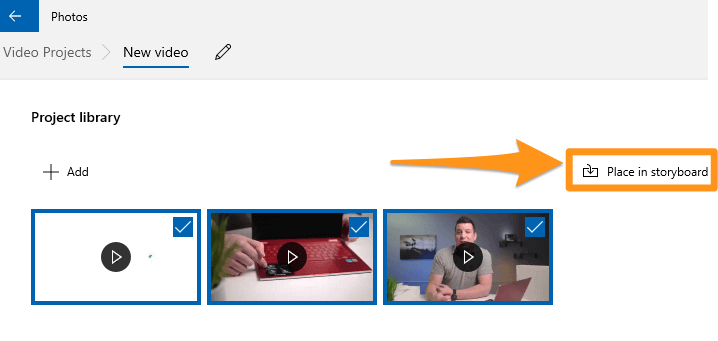
These are the steps to combine multiple clips in Windows 10 with Photos App.
Step 1: Open Photos App
Go to the ‘Start’ menu, find Photos App, and click to open it.
Step 2: Make a New Project
Click the ‘New video project’ (big blue box) under the ‘Video Projects’ tab. Alternatively, you can click the ‘New video’ button and select the ‘New video project’ option from the dropdown menu.
Step 3: Add Clips
Look for the text ‘Project library.’ Then click the ‘+ Add’ button. This will open a new window so you can select the clips you want to combine. Also, import videos one by one in a proper sequence because you cannot arrange them later.
Step 4: Make a Storyboard
After importing all the shots, you want to merge, click the ‘Place in storyboard’ button. This option will add all the chosen clips to your project’s storyboard.
- Fastreel by Movavi
Fastreel is a free online video editor. It is extremely easy to use right away, without installing anything. So, on Fastreel, one can edit videos or use online templates in the browser itself. Actually, the first tool we see in the list of Fastreel tools is to merge a video; then, it can be used in order to compress, make, cut, and create a video. On fastreel, you can add a watermark to a video, if wanted - so, it is very voluntary. As for the merging of a video, when this tool is chosen, it’s pretty simple to understand the steps – you can just drop/add multiple files right away.

The format must be either of the listed: MP4, MOV, MKV, AVI, and WMV, and the total size mustn’t exceed 500 MB. Then, in order to add some transitions, a style can be chosen from the drop-down menu, and after that, you should hit on Continue button to stitch the videos together. For the last step, you can export the result by selecting Download option.
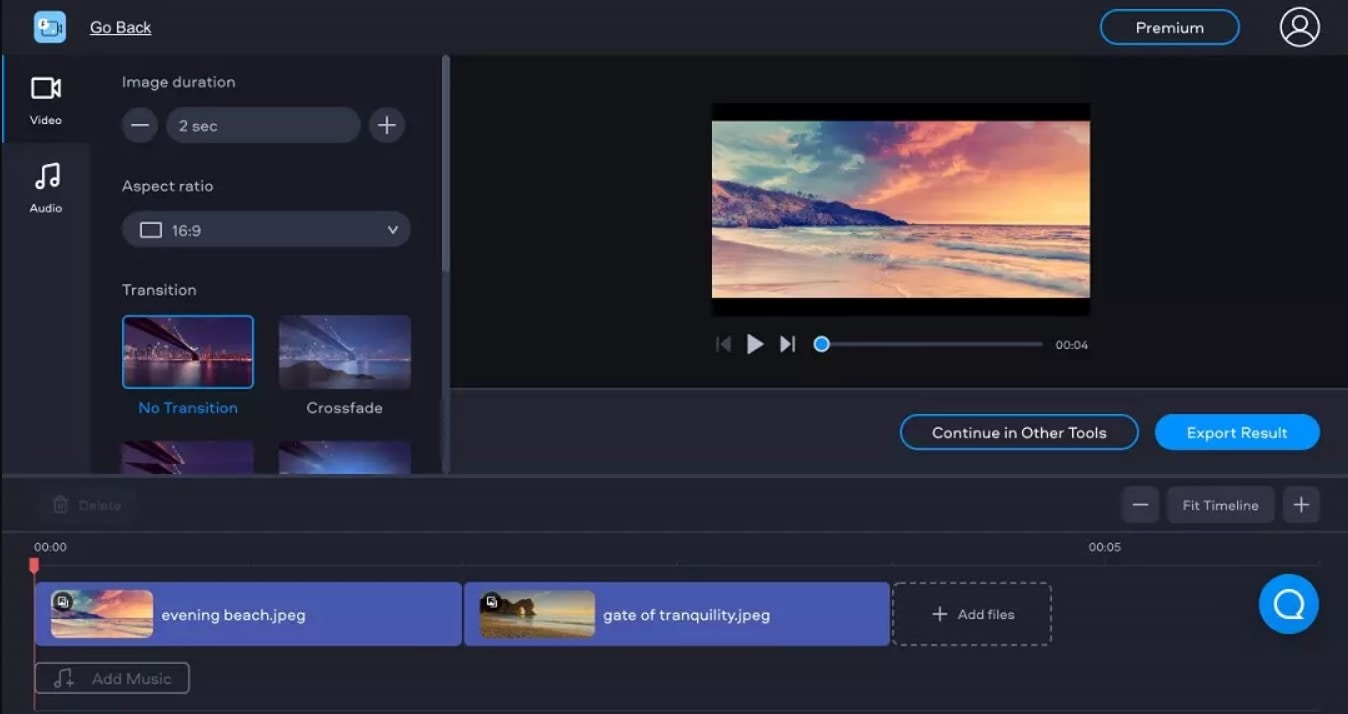
- Free Video Cutter Joiner
Free Video Cutter Joiner – the name already explains it all by itself! This is a free video merger which will not add watermark on your video. The software needs to be downloaded, and contributes to quickly cutting and joining videos. Free Video Cutter Joiner has no size limits – it can cut and merge videos with large file sizes without any trouble, and speed of it to do so is quite fast. It supports several file formats, such as AVI, MPEG, WMV, 3GP FLV, MP4, WMV, MOV, VOB, etc.
So, once downloaded, you will see how user-friendly and straightforward the software is: it shows two of its features right away – video cutter and video joiner. You choose which one you are about to use – so, in our case, video joiner.
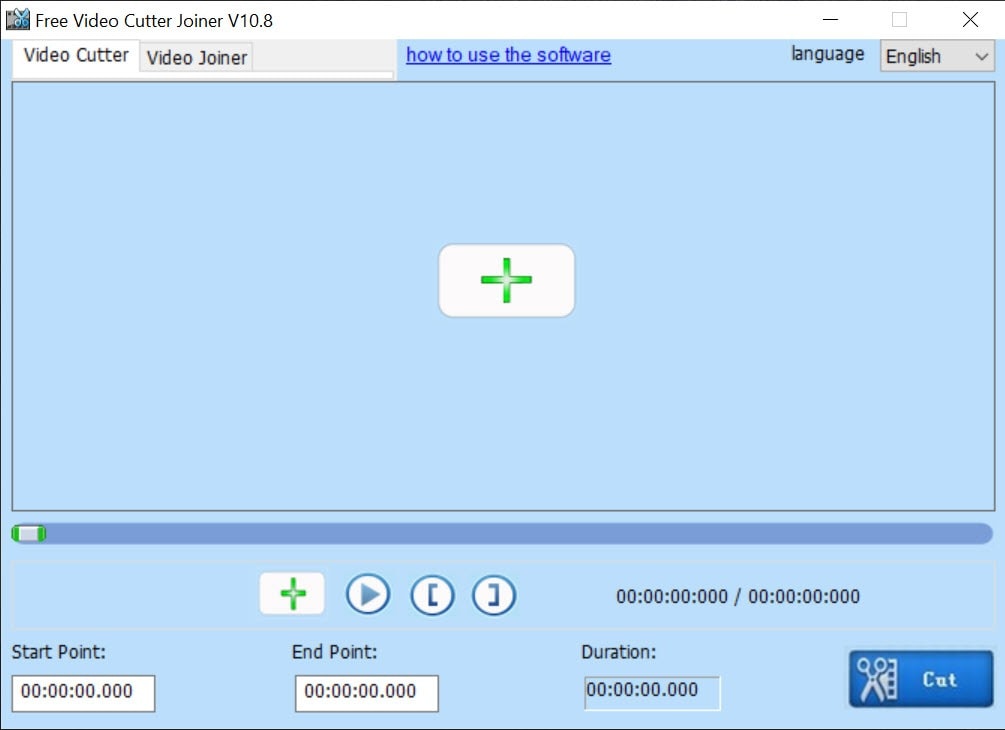
Then, you should click the the “+” icon, which lets you add files from your PC.

Then, hit on the Join button, and choose Indirect Join. Hitting on Start Join will start merging all the uploaded videos, and, wait a little until the process has been completed.
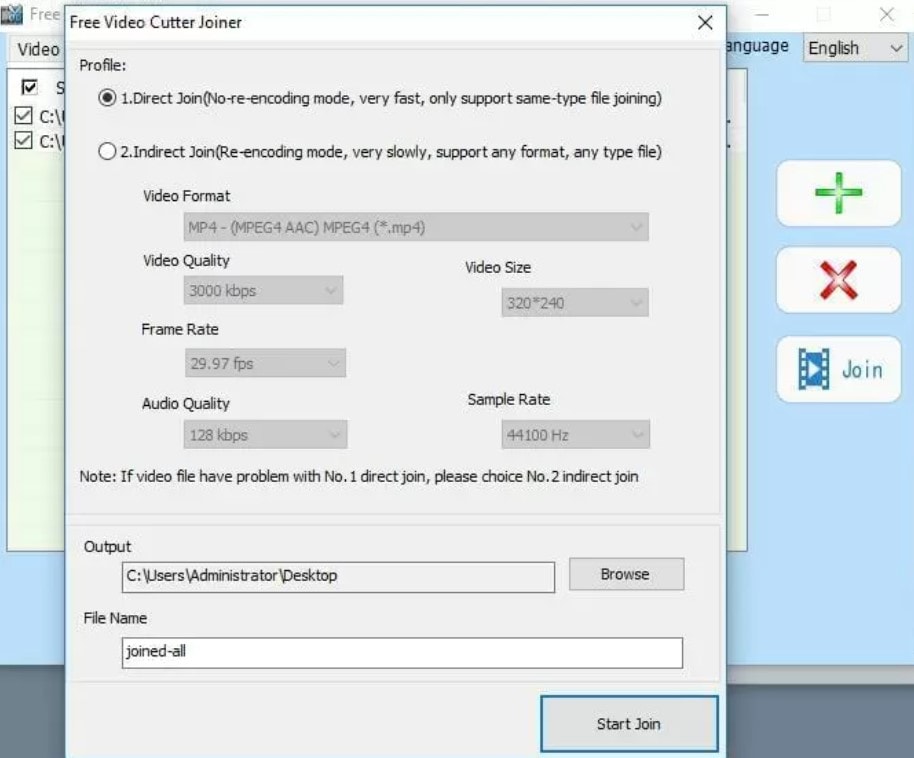
- Clideo
Clideo is the online platform that declares that it makes it super easy to edit all your video files, images and GIFs, and is totally free. It gives us the opportunities to: merge, compress, resize, cut, make, crop, speed, rotate, add music to, loop, flip, reverse, mute, filter, and adjust the videos. Add subtitles, make memes, create slideshows, etc. Therefore, it’s pretty rich in its tools and features.
As for merging videos, much like Fastreel, Clideo is pretty straightforward. You just click on the mentioned tool, and then easily choose files you would like to combine – you can merge any amount of video clips there. Several files can be chosen at the same time, or they can be added one by one.
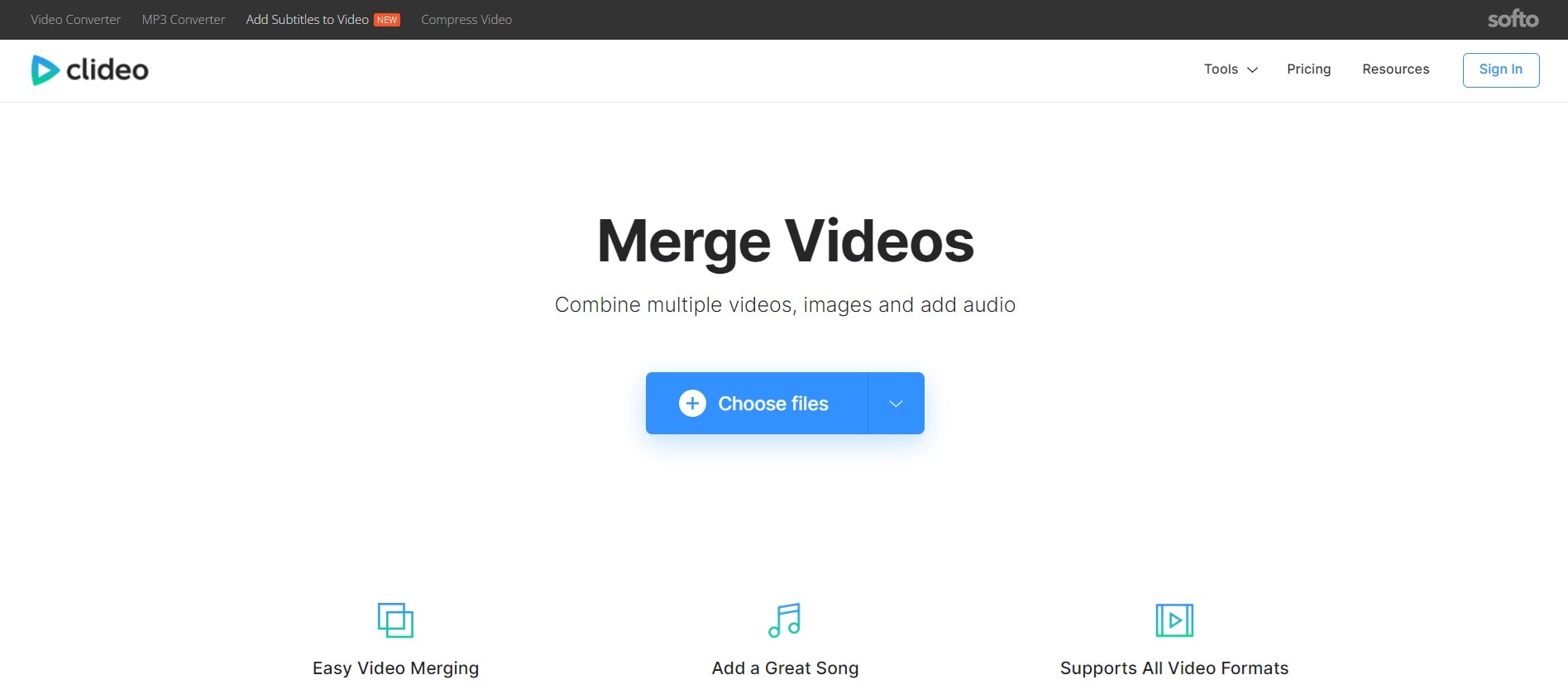
Then it will take you to the editor, where you can join the videos. It’s possible to rearrange the files, by using drag-and-drop until they’re in the desired order. You can also add images and set duration from them, add audio, change its length and volume. The last step is choosing the aspect ratio and clicking the Export button. You can watch the preview of your result and then click on Download if you are satisfied with the merged file.
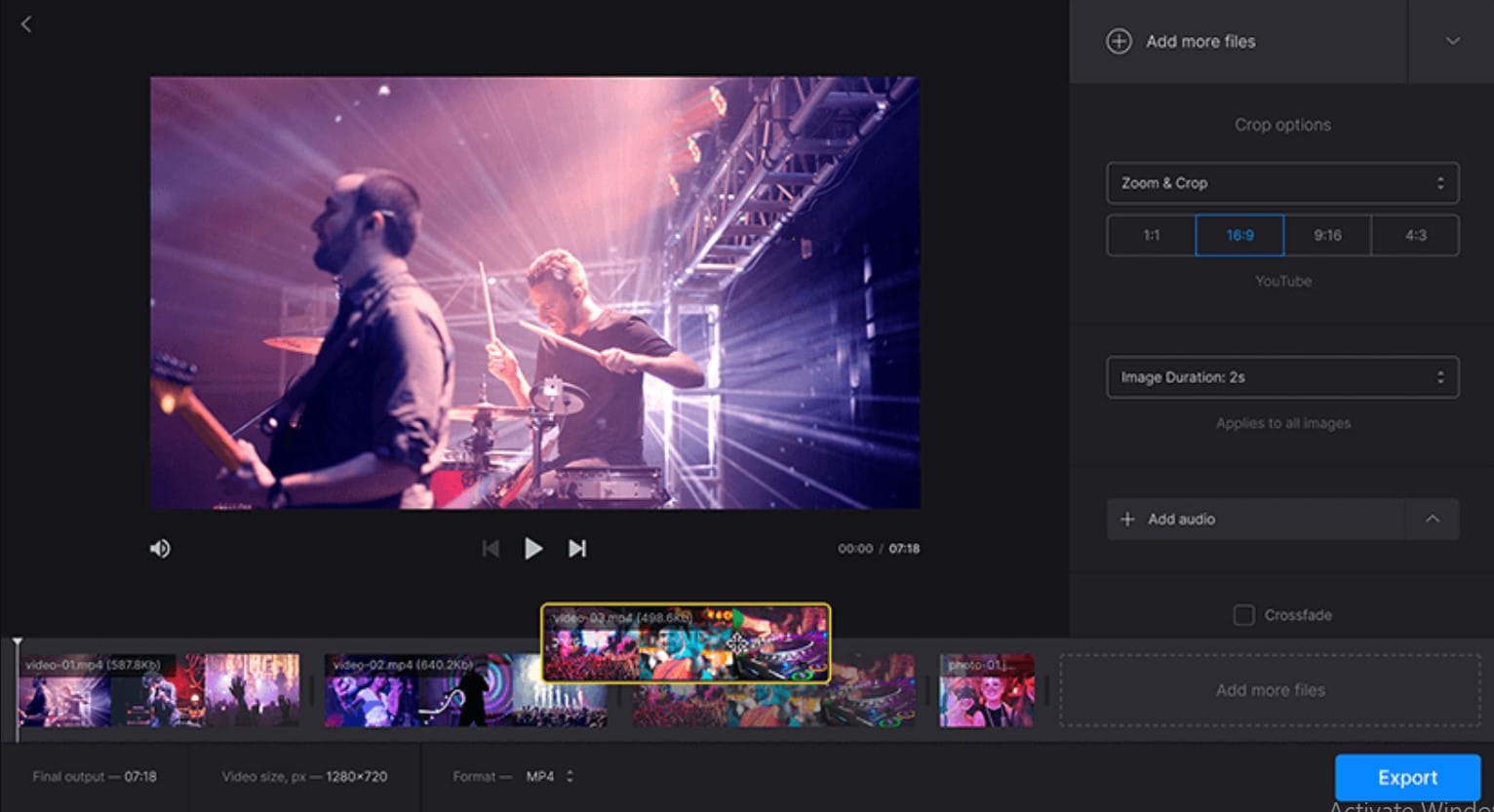
- Typito
Typito is a platform to merge videos online, as well as Fastreel and Clideo. It is free, and mostly aims to create combinations one can use to post on social network such as Instagram, Facebook, and Youtube. Typito supports a great many formats, some of them being MP4, AVI, FLV and WMV. You can edit your videos before merging them by trimming, cropping and resizing, and also add transition effects and music. It quickly combines footage, doesn’t watermark the videos, has brand kit of colors, fonts and style. It can also create collection of images, which is used for making Youtube compilation at most times.
To merge videos, you should choose the tool, then Get Started, and register and sign in first.
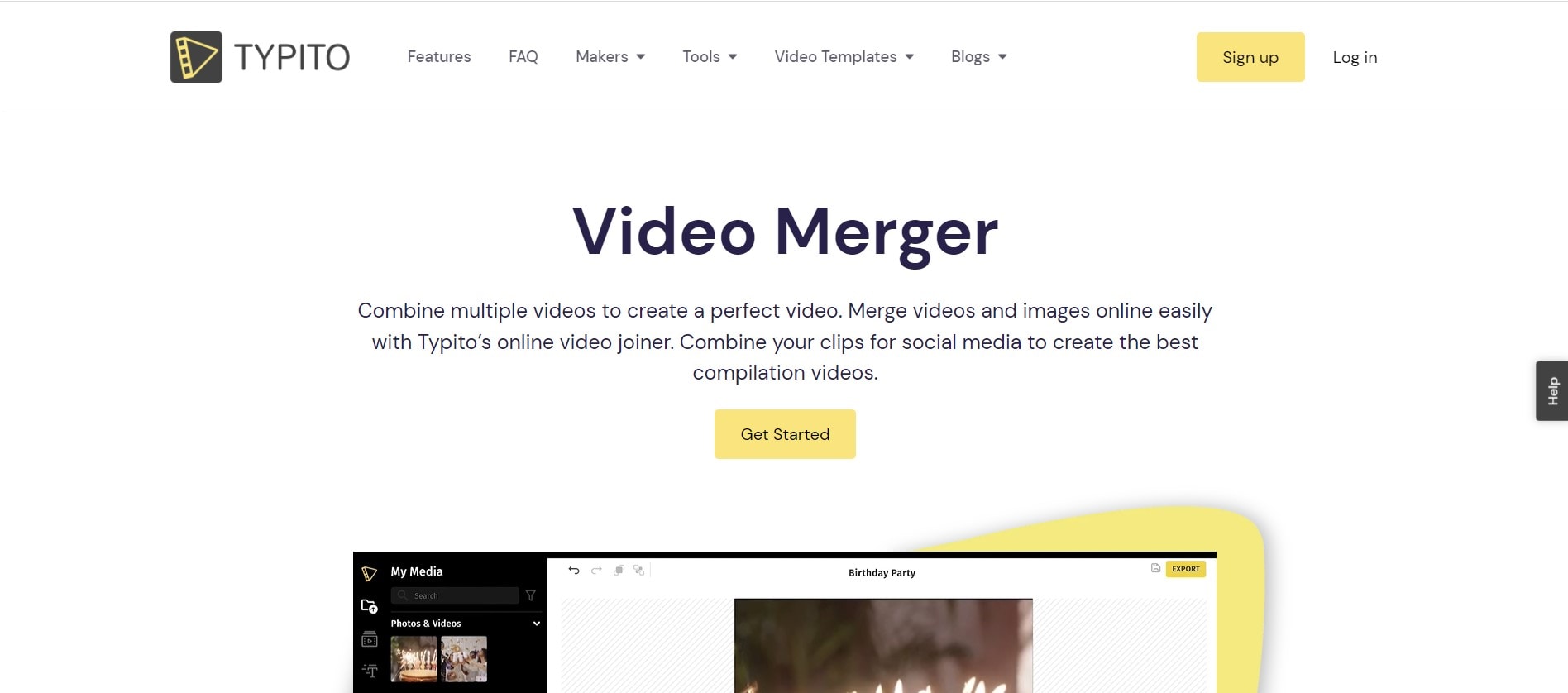
Then click on New Project, choose a video format (the platform offers you the list of the most popular ones), and it will take you to the editor, where you start off by adding media.
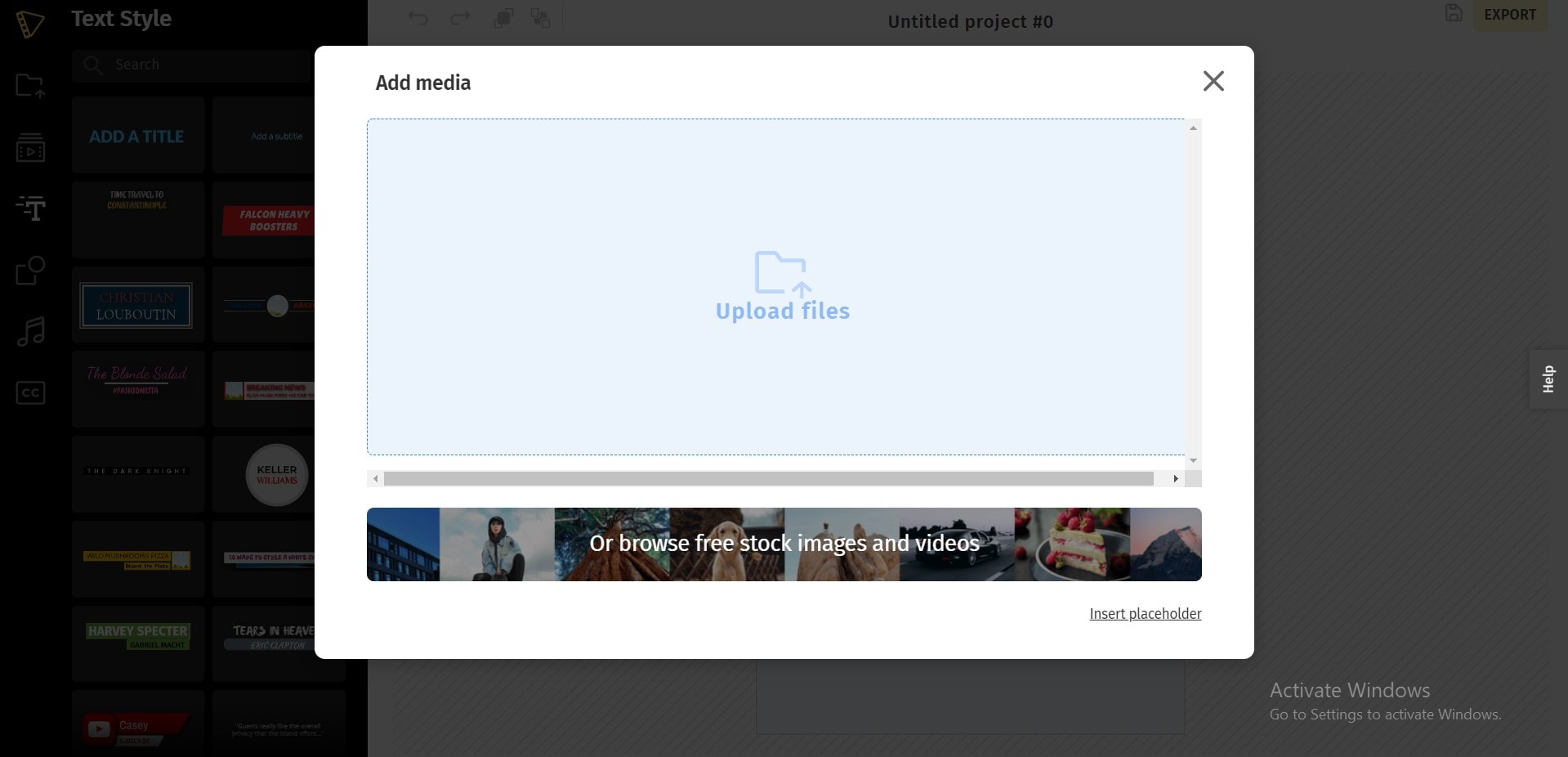
Drag and drop images or videos that you want to combine into a single video. You can also click to upload media files from your system or browse our Stock Media library for high-quality stock photos and video. Then, you can put your video clips in order, and work on it, if you want to use different tools, such as: edit, crop, trim, or resize them, as well as add text captions, images, and transitions. After you have previewed your video, you can click on the export button in the top right corner, and then, your merged video will be ready to be shared.
- Online UniConverter
Online UniConverter is the next online platform giving us the chance to merge our videos without watermark. It is an online analogue of Wondershare UniConverter, and is a very powerful platform, where you can trim, split, rotate, adjust, and download videos in HD quality. UniConverter supports numerous video formats, including MP4, AVI, MOV, MP3, WEBM. Online UniConverter offers various transitions and aspect ratios to fit the screen.
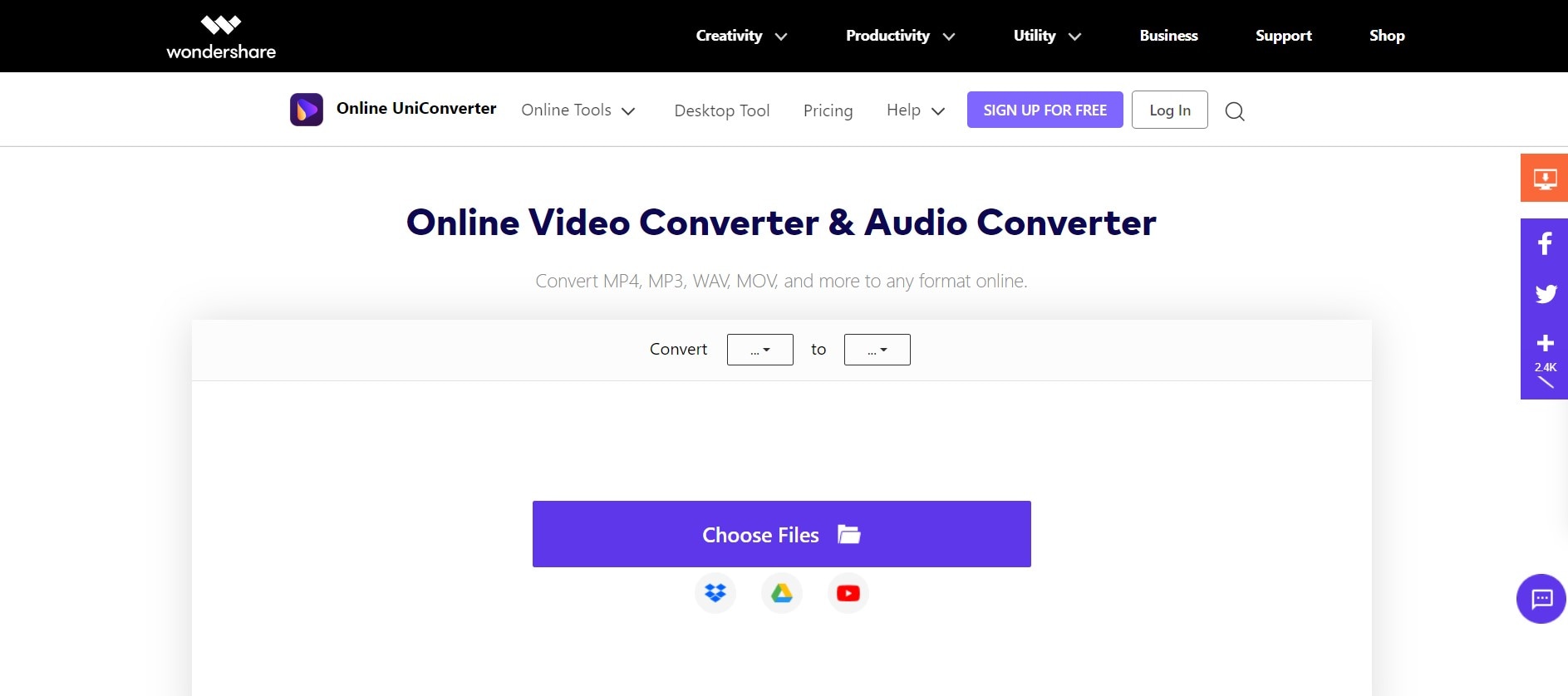
The web-site has lots of tools and features to offer: in the description of it, it reads: video converter, video compressor, video editor, audio converter, audio compressor, audio cutter, GIF maker, YouTube thumbnail, and image resizer. Importing media to the online UniConverter is extremely easy, and combining videos turns out to be a quick process, too.
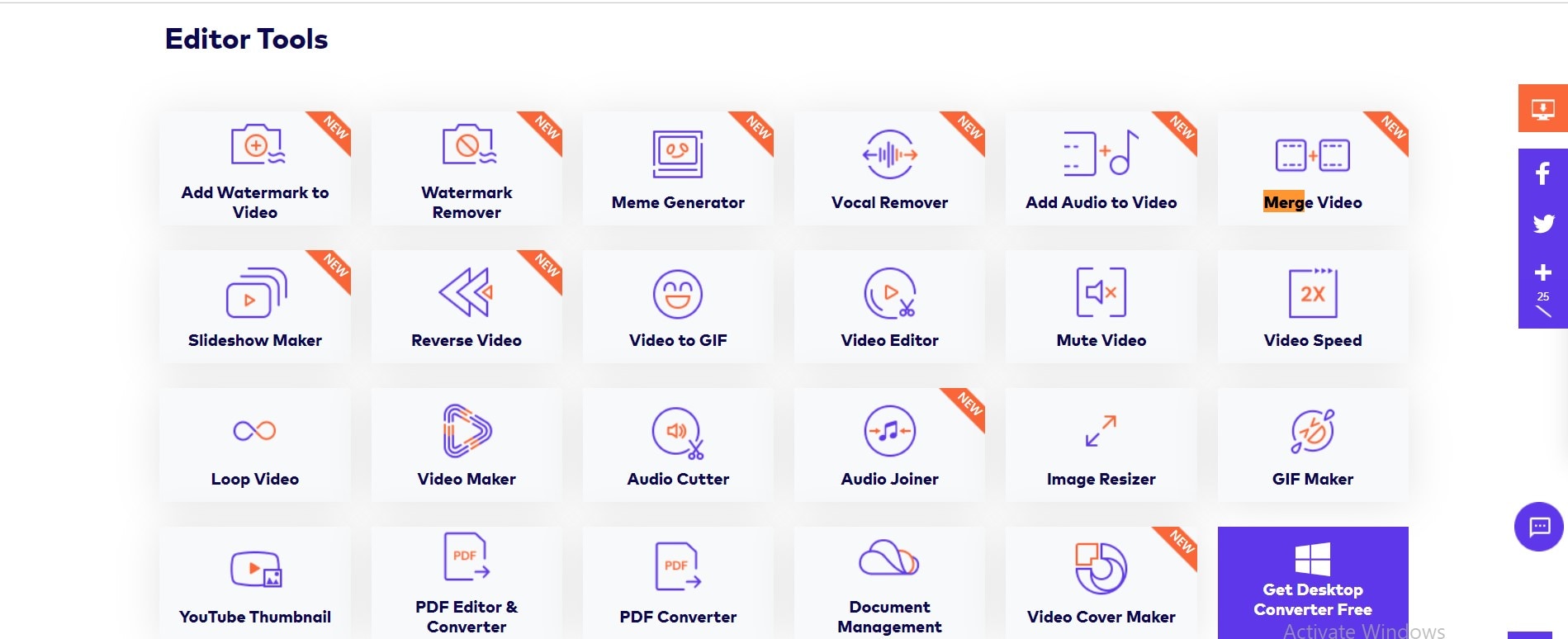
Anyway, if you want to combine a lot of files and the size of them all exceeds 100 MB, you will not be able to use Online Uniconverter for that. It supports the video no more than 100 MB and suggests using Wondershare UniConverter (originally Wondershare Video Converter Ultimate) for Desktop.
- Wondershare Filmora
Last but not least – Filmora Video Editor ! Even it differs from other abovementioned video mergers, as in it is not totally free and adds a Filmora logo on exported project, it’s a great suggestion for people who want to make their videos look great with the help of various tools. When a user is ready to pay, Filmora offers a subscription model, and for a bit more, one can get a permanent license. The software costs $51.99 per year or $79.99 for an outright purchase (prices are regularly discounted).
Wondershare Filmora has a clear and pleasing interface, offers trimming, transitions, overlays, several effects, as well as some more advanced and modern features, such as motion tracking. For this one particular software, we will be offering a step by step guide about how to merge videos there.
For Win 7 or later (64-bit)
For macOS 10.14 or later
- Open the program.
- Choose Import Media Files Here.

- Choose your
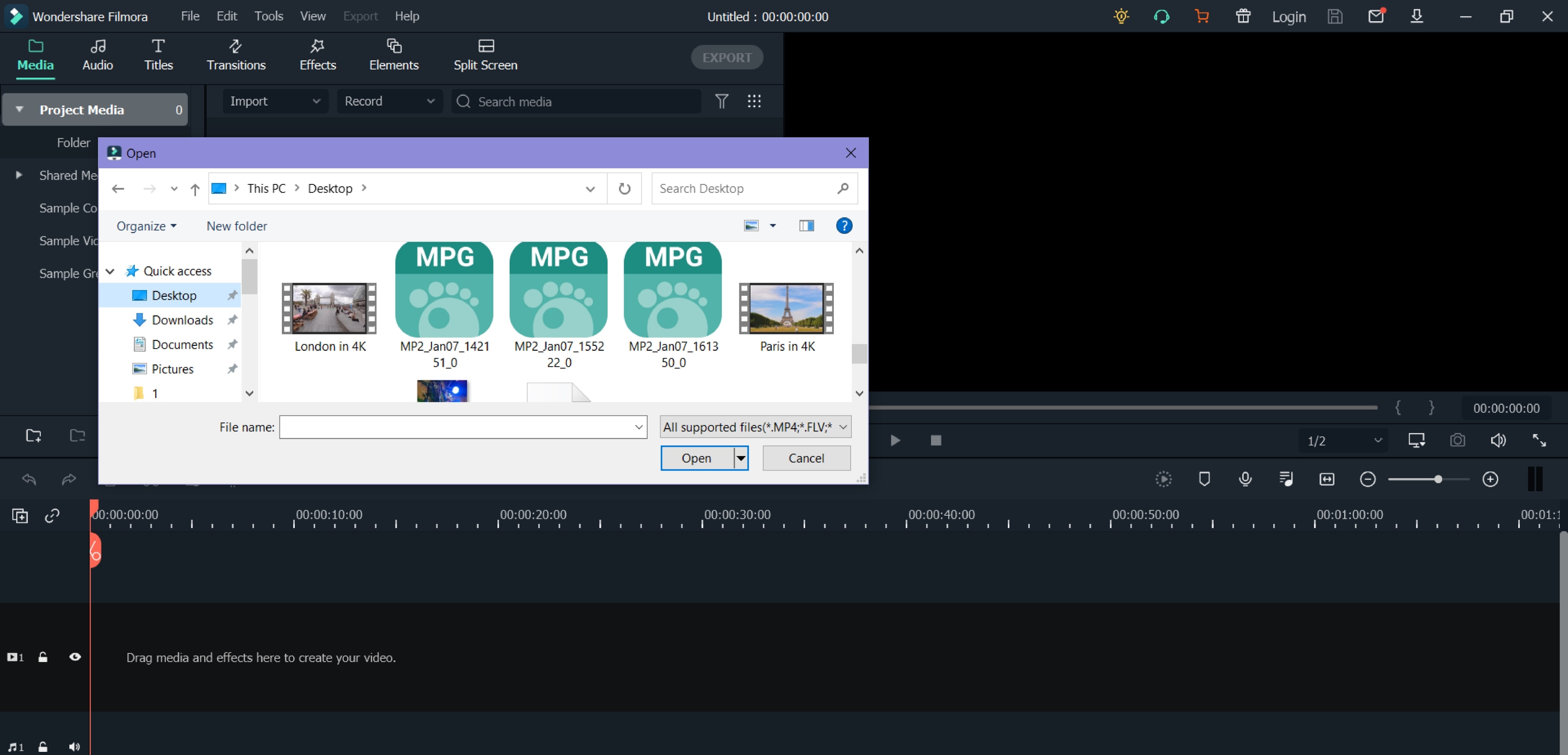
- We can click and drag, essentially, “insert” a video in a sequence below. The Linear Timeline allows us to understand exactly when a video clip ends and when a new one starts.

- Accordingly, we can make one video “sit” next to another. If we want or need it, we will add the third video clip, fourth, and so on.
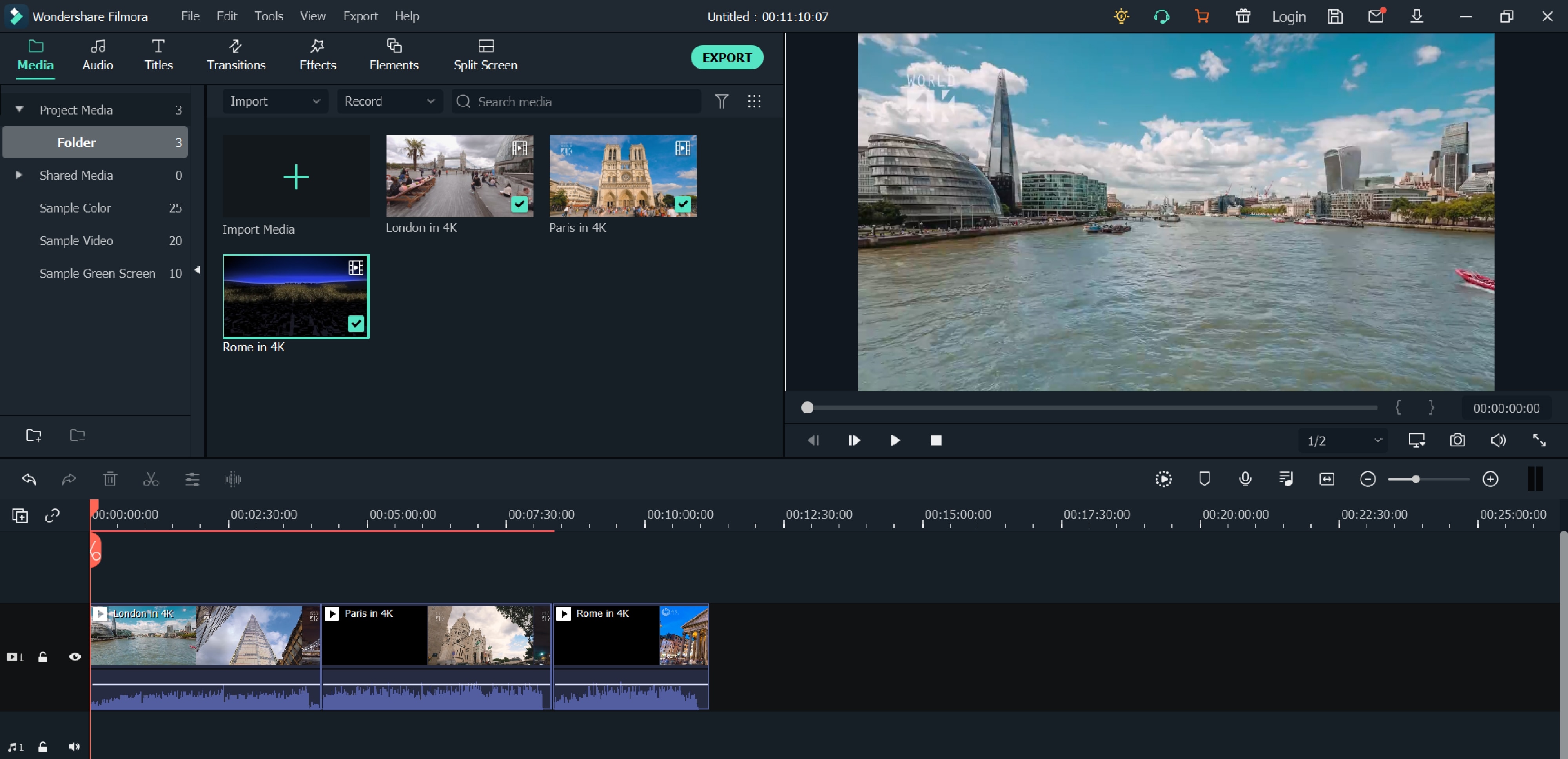
- We can view the entire video and save the video afterwards.
- Start to save video - we make sure the result is exactly what we wanted, find the Export button above the timeline and click on it.
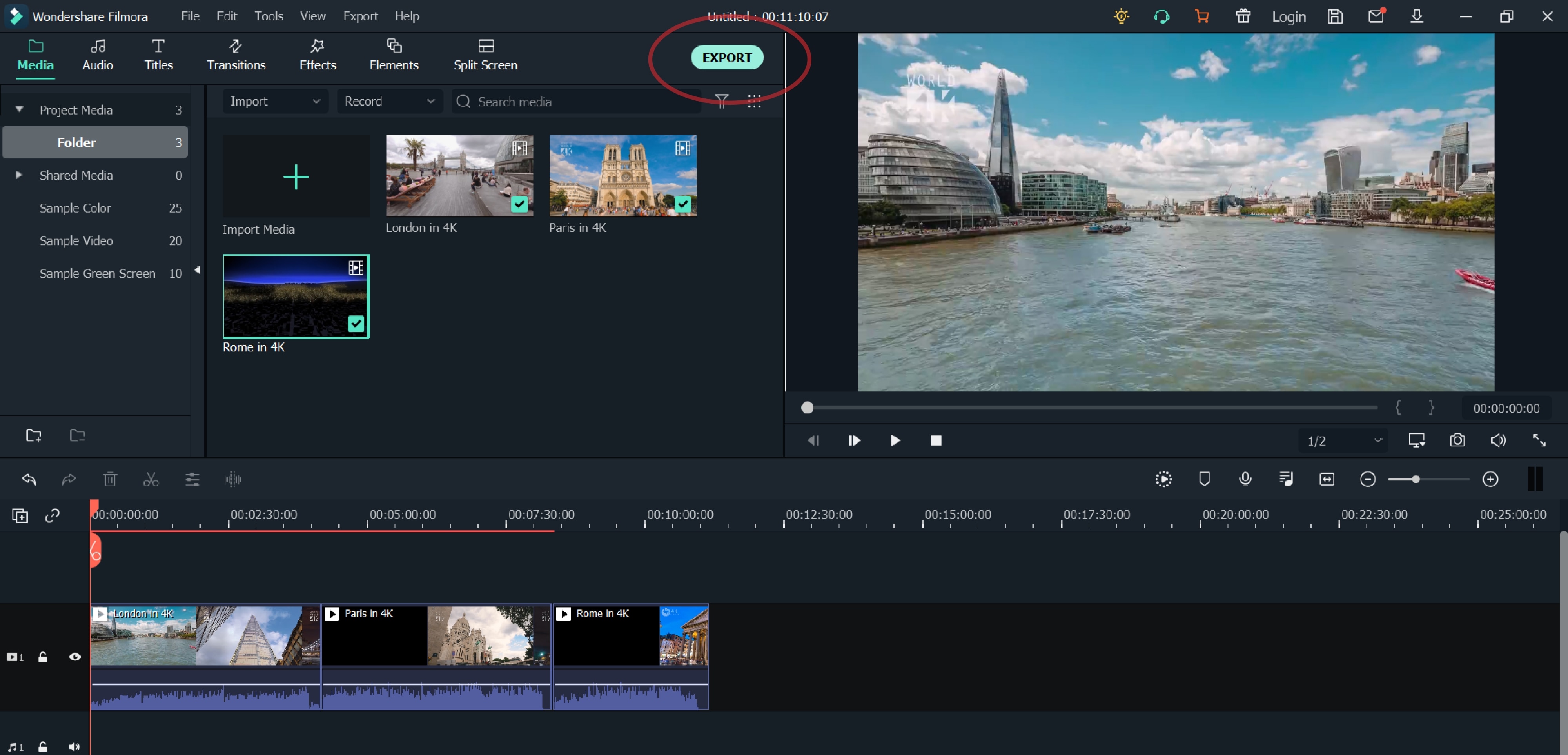
- In the opened window, on the left side, to be precise, if we observe well, we can already choose in which format we want to save our clip. On the right we can indicate what name we want to give to our video; The location where we want to store it; Also, we see the resolution (which we can modify freely after clicking on Settings); Size; Duration.
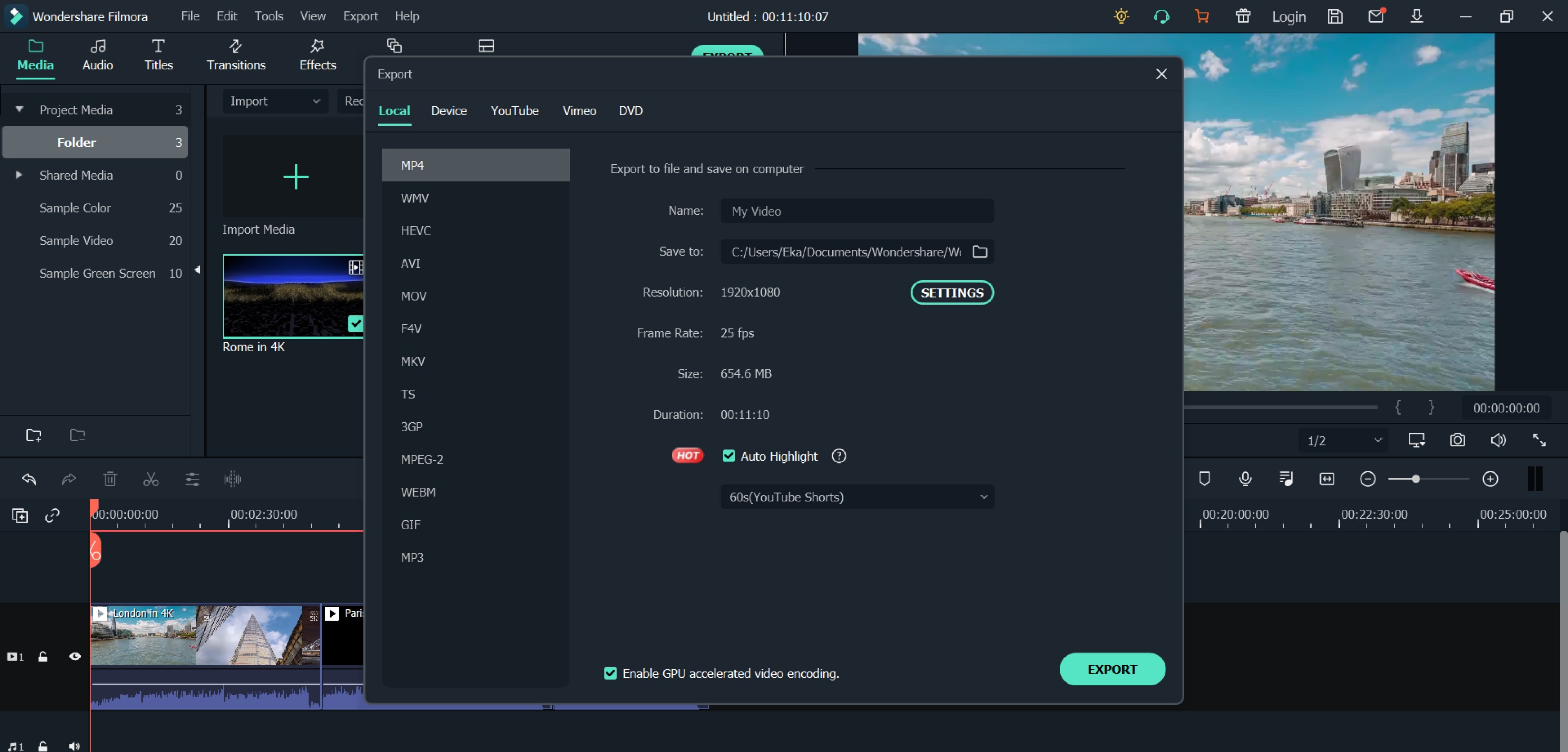
- In Settings, we can decide how much quality the video should have, how many kbps will be the Bit Rate, how many fps the Frame Rate should be, etc., but most likely, beginners will not need to change all this.
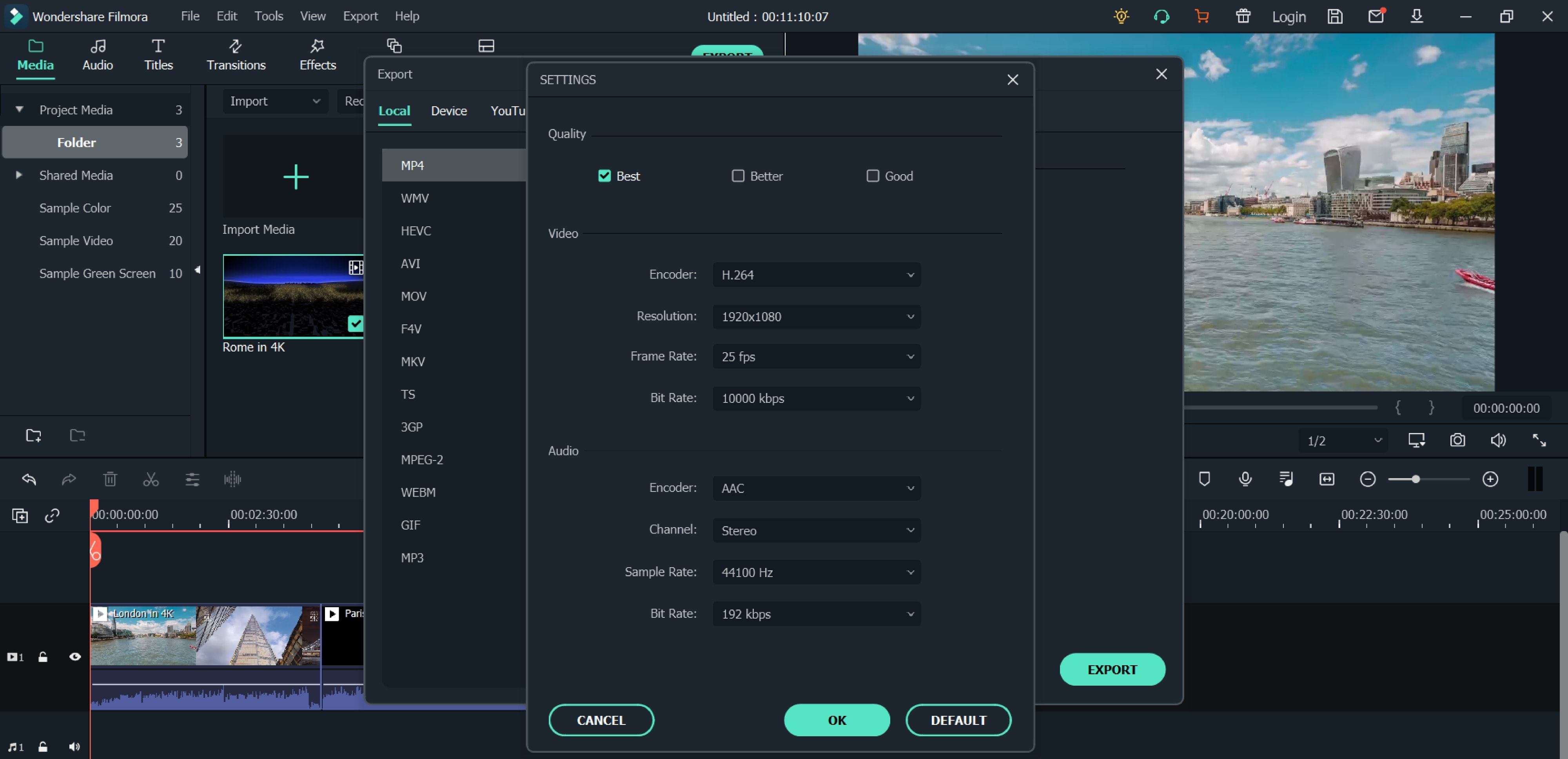
- After selecting everything, right-click on the Export button in the lower right corner of the window and the program will start saving the material.
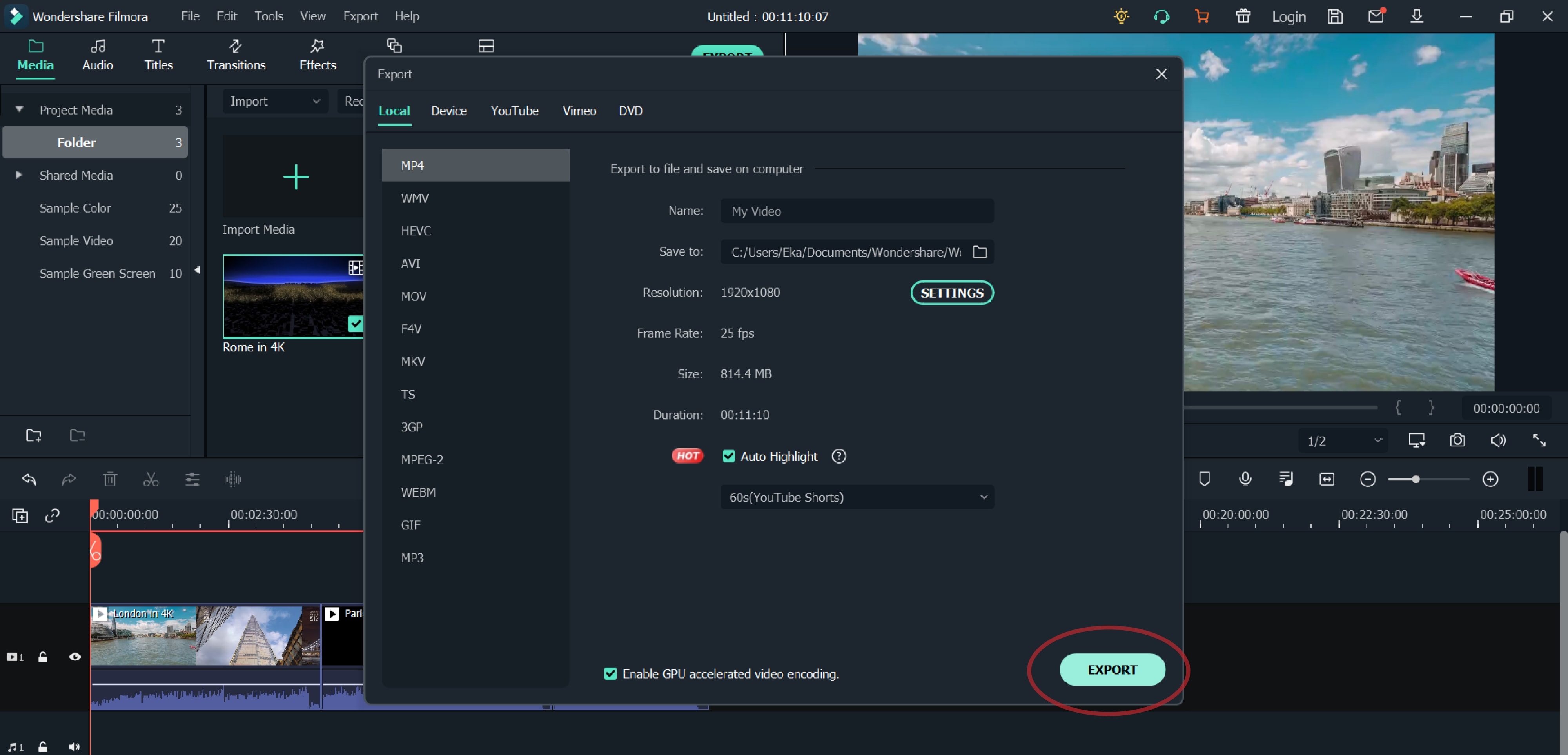

So, in this article, we introduced some online platforms and software for you to use if you would like to merge videos and combine them into one. These are: Fastreel, Free Video Cutter Joiner, Clideo, Typito, Online UniConverter, Wondershare Filmora. It’s up to you which one you would like to choose to merge your videos or edit them in any other way, but you can try either of them and choose to your own liking – even so, of course, there are some other video mergers worth considering, that we might mention in the coming articles. Before then, enjoy with free video editors, without watermark!
If you are too lazy to get high-quality results using popular video editors, like Filmora, try Photos App. It is a built-in program that usually opens your images on Windows 10, but you can also use it for merging your videos. And guess what? Since it comes within the system, all the features, although limited, are absolutely free.
How to Merge Videos on Windows using Photos App?

These are the steps to combine multiple clips in Windows 10 with Photos App.
Step 1: Open Photos App
Go to the ‘Start’ menu, find Photos App, and click to open it.
Step 2: Make a New Project
Click the ‘New video project’ (big blue box) under the ‘Video Projects’ tab. Alternatively, you can click the ‘New video’ button and select the ‘New video project’ option from the dropdown menu.
Step 3: Add Clips
Look for the text ‘Project library.’ Then click the ‘+ Add’ button. This will open a new window so you can select the clips you want to combine. Also, import videos one by one in a proper sequence because you cannot arrange them later.
Step 4: Make a Storyboard
After importing all the shots, you want to merge, click the ‘Place in storyboard’ button. This option will add all the chosen clips to your project’s storyboard.
- Fastreel by Movavi
Fastreel is a free online video editor. It is extremely easy to use right away, without installing anything. So, on Fastreel, one can edit videos or use online templates in the browser itself. Actually, the first tool we see in the list of Fastreel tools is to merge a video; then, it can be used in order to compress, make, cut, and create a video. On fastreel, you can add a watermark to a video, if wanted - so, it is very voluntary. As for the merging of a video, when this tool is chosen, it’s pretty simple to understand the steps – you can just drop/add multiple files right away.

The format must be either of the listed: MP4, MOV, MKV, AVI, and WMV, and the total size mustn’t exceed 500 MB. Then, in order to add some transitions, a style can be chosen from the drop-down menu, and after that, you should hit on Continue button to stitch the videos together. For the last step, you can export the result by selecting Download option.

- Free Video Cutter Joiner
Free Video Cutter Joiner – the name already explains it all by itself! This is a free video merger which will not add watermark on your video. The software needs to be downloaded, and contributes to quickly cutting and joining videos. Free Video Cutter Joiner has no size limits – it can cut and merge videos with large file sizes without any trouble, and speed of it to do so is quite fast. It supports several file formats, such as AVI, MPEG, WMV, 3GP FLV, MP4, WMV, MOV, VOB, etc.
So, once downloaded, you will see how user-friendly and straightforward the software is: it shows two of its features right away – video cutter and video joiner. You choose which one you are about to use – so, in our case, video joiner.

Then, you should click the the “+” icon, which lets you add files from your PC.

Then, hit on the Join button, and choose Indirect Join. Hitting on Start Join will start merging all the uploaded videos, and, wait a little until the process has been completed.

- Clideo
Clideo is the online platform that declares that it makes it super easy to edit all your video files, images and GIFs, and is totally free. It gives us the opportunities to: merge, compress, resize, cut, make, crop, speed, rotate, add music to, loop, flip, reverse, mute, filter, and adjust the videos. Add subtitles, make memes, create slideshows, etc. Therefore, it’s pretty rich in its tools and features.
As for merging videos, much like Fastreel, Clideo is pretty straightforward. You just click on the mentioned tool, and then easily choose files you would like to combine – you can merge any amount of video clips there. Several files can be chosen at the same time, or they can be added one by one.

Then it will take you to the editor, where you can join the videos. It’s possible to rearrange the files, by using drag-and-drop until they’re in the desired order. You can also add images and set duration from them, add audio, change its length and volume. The last step is choosing the aspect ratio and clicking the Export button. You can watch the preview of your result and then click on Download if you are satisfied with the merged file.

- Typito
Typito is a platform to merge videos online, as well as Fastreel and Clideo. It is free, and mostly aims to create combinations one can use to post on social network such as Instagram, Facebook, and Youtube. Typito supports a great many formats, some of them being MP4, AVI, FLV and WMV. You can edit your videos before merging them by trimming, cropping and resizing, and also add transition effects and music. It quickly combines footage, doesn’t watermark the videos, has brand kit of colors, fonts and style. It can also create collection of images, which is used for making Youtube compilation at most times.
To merge videos, you should choose the tool, then Get Started, and register and sign in first.

Then click on New Project, choose a video format (the platform offers you the list of the most popular ones), and it will take you to the editor, where you start off by adding media.

Drag and drop images or videos that you want to combine into a single video. You can also click to upload media files from your system or browse our Stock Media library for high-quality stock photos and video. Then, you can put your video clips in order, and work on it, if you want to use different tools, such as: edit, crop, trim, or resize them, as well as add text captions, images, and transitions. After you have previewed your video, you can click on the export button in the top right corner, and then, your merged video will be ready to be shared.
- Online UniConverter
Online UniConverter is the next online platform giving us the chance to merge our videos without watermark. It is an online analogue of Wondershare UniConverter, and is a very powerful platform, where you can trim, split, rotate, adjust, and download videos in HD quality. UniConverter supports numerous video formats, including MP4, AVI, MOV, MP3, WEBM. Online UniConverter offers various transitions and aspect ratios to fit the screen.

The web-site has lots of tools and features to offer: in the description of it, it reads: video converter, video compressor, video editor, audio converter, audio compressor, audio cutter, GIF maker, YouTube thumbnail, and image resizer. Importing media to the online UniConverter is extremely easy, and combining videos turns out to be a quick process, too.

Anyway, if you want to combine a lot of files and the size of them all exceeds 100 MB, you will not be able to use Online Uniconverter for that. It supports the video no more than 100 MB and suggests using Wondershare UniConverter (originally Wondershare Video Converter Ultimate) for Desktop.
- Wondershare Filmora
Last but not least – Filmora Video Editor ! Even it differs from other abovementioned video mergers, as in it is not totally free and adds a Filmora logo on exported project, it’s a great suggestion for people who want to make their videos look great with the help of various tools. When a user is ready to pay, Filmora offers a subscription model, and for a bit more, one can get a permanent license. The software costs $51.99 per year or $79.99 for an outright purchase (prices are regularly discounted).
Wondershare Filmora has a clear and pleasing interface, offers trimming, transitions, overlays, several effects, as well as some more advanced and modern features, such as motion tracking. For this one particular software, we will be offering a step by step guide about how to merge videos there.
For Win 7 or later (64-bit)
For macOS 10.14 or later
- Open the program.
- Choose Import Media Files Here.

- Choose your

- We can click and drag, essentially, “insert” a video in a sequence below. The Linear Timeline allows us to understand exactly when a video clip ends and when a new one starts.

- Accordingly, we can make one video “sit” next to another. If we want or need it, we will add the third video clip, fourth, and so on.

- We can view the entire video and save the video afterwards.
- Start to save video - we make sure the result is exactly what we wanted, find the Export button above the timeline and click on it.

- In the opened window, on the left side, to be precise, if we observe well, we can already choose in which format we want to save our clip. On the right we can indicate what name we want to give to our video; The location where we want to store it; Also, we see the resolution (which we can modify freely after clicking on Settings); Size; Duration.

- In Settings, we can decide how much quality the video should have, how many kbps will be the Bit Rate, how many fps the Frame Rate should be, etc., but most likely, beginners will not need to change all this.

- After selecting everything, right-click on the Export button in the lower right corner of the window and the program will start saving the material.


So, in this article, we introduced some online platforms and software for you to use if you would like to merge videos and combine them into one. These are: Fastreel, Free Video Cutter Joiner, Clideo, Typito, Online UniConverter, Wondershare Filmora. It’s up to you which one you would like to choose to merge your videos or edit them in any other way, but you can try either of them and choose to your own liking – even so, of course, there are some other video mergers worth considering, that we might mention in the coming articles. Before then, enjoy with free video editors, without watermark!
If you are too lazy to get high-quality results using popular video editors, like Filmora, try Photos App. It is a built-in program that usually opens your images on Windows 10, but you can also use it for merging your videos. And guess what? Since it comes within the system, all the features, although limited, are absolutely free.
How to Merge Videos on Windows using Photos App?

These are the steps to combine multiple clips in Windows 10 with Photos App.
Step 1: Open Photos App
Go to the ‘Start’ menu, find Photos App, and click to open it.
Step 2: Make a New Project
Click the ‘New video project’ (big blue box) under the ‘Video Projects’ tab. Alternatively, you can click the ‘New video’ button and select the ‘New video project’ option from the dropdown menu.
Step 3: Add Clips
Look for the text ‘Project library.’ Then click the ‘+ Add’ button. This will open a new window so you can select the clips you want to combine. Also, import videos one by one in a proper sequence because you cannot arrange them later.
Step 4: Make a Storyboard
After importing all the shots, you want to merge, click the ‘Place in storyboard’ button. This option will add all the chosen clips to your project’s storyboard.
- Fastreel by Movavi
Fastreel is a free online video editor. It is extremely easy to use right away, without installing anything. So, on Fastreel, one can edit videos or use online templates in the browser itself. Actually, the first tool we see in the list of Fastreel tools is to merge a video; then, it can be used in order to compress, make, cut, and create a video. On fastreel, you can add a watermark to a video, if wanted - so, it is very voluntary. As for the merging of a video, when this tool is chosen, it’s pretty simple to understand the steps – you can just drop/add multiple files right away.

The format must be either of the listed: MP4, MOV, MKV, AVI, and WMV, and the total size mustn’t exceed 500 MB. Then, in order to add some transitions, a style can be chosen from the drop-down menu, and after that, you should hit on Continue button to stitch the videos together. For the last step, you can export the result by selecting Download option.

- Free Video Cutter Joiner
Free Video Cutter Joiner – the name already explains it all by itself! This is a free video merger which will not add watermark on your video. The software needs to be downloaded, and contributes to quickly cutting and joining videos. Free Video Cutter Joiner has no size limits – it can cut and merge videos with large file sizes without any trouble, and speed of it to do so is quite fast. It supports several file formats, such as AVI, MPEG, WMV, 3GP FLV, MP4, WMV, MOV, VOB, etc.
So, once downloaded, you will see how user-friendly and straightforward the software is: it shows two of its features right away – video cutter and video joiner. You choose which one you are about to use – so, in our case, video joiner.

Then, you should click the the “+” icon, which lets you add files from your PC.

Then, hit on the Join button, and choose Indirect Join. Hitting on Start Join will start merging all the uploaded videos, and, wait a little until the process has been completed.

- Clideo
Clideo is the online platform that declares that it makes it super easy to edit all your video files, images and GIFs, and is totally free. It gives us the opportunities to: merge, compress, resize, cut, make, crop, speed, rotate, add music to, loop, flip, reverse, mute, filter, and adjust the videos. Add subtitles, make memes, create slideshows, etc. Therefore, it’s pretty rich in its tools and features.
As for merging videos, much like Fastreel, Clideo is pretty straightforward. You just click on the mentioned tool, and then easily choose files you would like to combine – you can merge any amount of video clips there. Several files can be chosen at the same time, or they can be added one by one.

Then it will take you to the editor, where you can join the videos. It’s possible to rearrange the files, by using drag-and-drop until they’re in the desired order. You can also add images and set duration from them, add audio, change its length and volume. The last step is choosing the aspect ratio and clicking the Export button. You can watch the preview of your result and then click on Download if you are satisfied with the merged file.

- Typito
Typito is a platform to merge videos online, as well as Fastreel and Clideo. It is free, and mostly aims to create combinations one can use to post on social network such as Instagram, Facebook, and Youtube. Typito supports a great many formats, some of them being MP4, AVI, FLV and WMV. You can edit your videos before merging them by trimming, cropping and resizing, and also add transition effects and music. It quickly combines footage, doesn’t watermark the videos, has brand kit of colors, fonts and style. It can also create collection of images, which is used for making Youtube compilation at most times.
To merge videos, you should choose the tool, then Get Started, and register and sign in first.

Then click on New Project, choose a video format (the platform offers you the list of the most popular ones), and it will take you to the editor, where you start off by adding media.

Drag and drop images or videos that you want to combine into a single video. You can also click to upload media files from your system or browse our Stock Media library for high-quality stock photos and video. Then, you can put your video clips in order, and work on it, if you want to use different tools, such as: edit, crop, trim, or resize them, as well as add text captions, images, and transitions. After you have previewed your video, you can click on the export button in the top right corner, and then, your merged video will be ready to be shared.
- Online UniConverter
Online UniConverter is the next online platform giving us the chance to merge our videos without watermark. It is an online analogue of Wondershare UniConverter, and is a very powerful platform, where you can trim, split, rotate, adjust, and download videos in HD quality. UniConverter supports numerous video formats, including MP4, AVI, MOV, MP3, WEBM. Online UniConverter offers various transitions and aspect ratios to fit the screen.

The web-site has lots of tools and features to offer: in the description of it, it reads: video converter, video compressor, video editor, audio converter, audio compressor, audio cutter, GIF maker, YouTube thumbnail, and image resizer. Importing media to the online UniConverter is extremely easy, and combining videos turns out to be a quick process, too.

Anyway, if you want to combine a lot of files and the size of them all exceeds 100 MB, you will not be able to use Online Uniconverter for that. It supports the video no more than 100 MB and suggests using Wondershare UniConverter (originally Wondershare Video Converter Ultimate) for Desktop.
- Wondershare Filmora
Last but not least – Filmora Video Editor ! Even it differs from other abovementioned video mergers, as in it is not totally free and adds a Filmora logo on exported project, it’s a great suggestion for people who want to make their videos look great with the help of various tools. When a user is ready to pay, Filmora offers a subscription model, and for a bit more, one can get a permanent license. The software costs $51.99 per year or $79.99 for an outright purchase (prices are regularly discounted).
Wondershare Filmora has a clear and pleasing interface, offers trimming, transitions, overlays, several effects, as well as some more advanced and modern features, such as motion tracking. For this one particular software, we will be offering a step by step guide about how to merge videos there.
For Win 7 or later (64-bit)
For macOS 10.14 or later
- Open the program.
- Choose Import Media Files Here.

- Choose your

- We can click and drag, essentially, “insert” a video in a sequence below. The Linear Timeline allows us to understand exactly when a video clip ends and when a new one starts.

- Accordingly, we can make one video “sit” next to another. If we want or need it, we will add the third video clip, fourth, and so on.

- We can view the entire video and save the video afterwards.
- Start to save video - we make sure the result is exactly what we wanted, find the Export button above the timeline and click on it.

- In the opened window, on the left side, to be precise, if we observe well, we can already choose in which format we want to save our clip. On the right we can indicate what name we want to give to our video; The location where we want to store it; Also, we see the resolution (which we can modify freely after clicking on Settings); Size; Duration.

- In Settings, we can decide how much quality the video should have, how many kbps will be the Bit Rate, how many fps the Frame Rate should be, etc., but most likely, beginners will not need to change all this.

- After selecting everything, right-click on the Export button in the lower right corner of the window and the program will start saving the material.


So, in this article, we introduced some online platforms and software for you to use if you would like to merge videos and combine them into one. These are: Fastreel, Free Video Cutter Joiner, Clideo, Typito, Online UniConverter, Wondershare Filmora. It’s up to you which one you would like to choose to merge your videos or edit them in any other way, but you can try either of them and choose to your own liking – even so, of course, there are some other video mergers worth considering, that we might mention in the coming articles. Before then, enjoy with free video editors, without watermark!
If you are too lazy to get high-quality results using popular video editors, like Filmora, try Photos App. It is a built-in program that usually opens your images on Windows 10, but you can also use it for merging your videos. And guess what? Since it comes within the system, all the features, although limited, are absolutely free.
How to Merge Videos on Windows using Photos App?

These are the steps to combine multiple clips in Windows 10 with Photos App.
Step 1: Open Photos App
Go to the ‘Start’ menu, find Photos App, and click to open it.
Step 2: Make a New Project
Click the ‘New video project’ (big blue box) under the ‘Video Projects’ tab. Alternatively, you can click the ‘New video’ button and select the ‘New video project’ option from the dropdown menu.
Step 3: Add Clips
Look for the text ‘Project library.’ Then click the ‘+ Add’ button. This will open a new window so you can select the clips you want to combine. Also, import videos one by one in a proper sequence because you cannot arrange them later.
Step 4: Make a Storyboard
After importing all the shots, you want to merge, click the ‘Place in storyboard’ button. This option will add all the chosen clips to your project’s storyboard.
- Fastreel by Movavi
Fastreel is a free online video editor. It is extremely easy to use right away, without installing anything. So, on Fastreel, one can edit videos or use online templates in the browser itself. Actually, the first tool we see in the list of Fastreel tools is to merge a video; then, it can be used in order to compress, make, cut, and create a video. On fastreel, you can add a watermark to a video, if wanted - so, it is very voluntary. As for the merging of a video, when this tool is chosen, it’s pretty simple to understand the steps – you can just drop/add multiple files right away.

The format must be either of the listed: MP4, MOV, MKV, AVI, and WMV, and the total size mustn’t exceed 500 MB. Then, in order to add some transitions, a style can be chosen from the drop-down menu, and after that, you should hit on Continue button to stitch the videos together. For the last step, you can export the result by selecting Download option.

- Free Video Cutter Joiner
Free Video Cutter Joiner – the name already explains it all by itself! This is a free video merger which will not add watermark on your video. The software needs to be downloaded, and contributes to quickly cutting and joining videos. Free Video Cutter Joiner has no size limits – it can cut and merge videos with large file sizes without any trouble, and speed of it to do so is quite fast. It supports several file formats, such as AVI, MPEG, WMV, 3GP FLV, MP4, WMV, MOV, VOB, etc.
So, once downloaded, you will see how user-friendly and straightforward the software is: it shows two of its features right away – video cutter and video joiner. You choose which one you are about to use – so, in our case, video joiner.

Then, you should click the the “+” icon, which lets you add files from your PC.

Then, hit on the Join button, and choose Indirect Join. Hitting on Start Join will start merging all the uploaded videos, and, wait a little until the process has been completed.

- Clideo
Clideo is the online platform that declares that it makes it super easy to edit all your video files, images and GIFs, and is totally free. It gives us the opportunities to: merge, compress, resize, cut, make, crop, speed, rotate, add music to, loop, flip, reverse, mute, filter, and adjust the videos. Add subtitles, make memes, create slideshows, etc. Therefore, it’s pretty rich in its tools and features.
As for merging videos, much like Fastreel, Clideo is pretty straightforward. You just click on the mentioned tool, and then easily choose files you would like to combine – you can merge any amount of video clips there. Several files can be chosen at the same time, or they can be added one by one.

Then it will take you to the editor, where you can join the videos. It’s possible to rearrange the files, by using drag-and-drop until they’re in the desired order. You can also add images and set duration from them, add audio, change its length and volume. The last step is choosing the aspect ratio and clicking the Export button. You can watch the preview of your result and then click on Download if you are satisfied with the merged file.

- Typito
Typito is a platform to merge videos online, as well as Fastreel and Clideo. It is free, and mostly aims to create combinations one can use to post on social network such as Instagram, Facebook, and Youtube. Typito supports a great many formats, some of them being MP4, AVI, FLV and WMV. You can edit your videos before merging them by trimming, cropping and resizing, and also add transition effects and music. It quickly combines footage, doesn’t watermark the videos, has brand kit of colors, fonts and style. It can also create collection of images, which is used for making Youtube compilation at most times.
To merge videos, you should choose the tool, then Get Started, and register and sign in first.

Then click on New Project, choose a video format (the platform offers you the list of the most popular ones), and it will take you to the editor, where you start off by adding media.

Drag and drop images or videos that you want to combine into a single video. You can also click to upload media files from your system or browse our Stock Media library for high-quality stock photos and video. Then, you can put your video clips in order, and work on it, if you want to use different tools, such as: edit, crop, trim, or resize them, as well as add text captions, images, and transitions. After you have previewed your video, you can click on the export button in the top right corner, and then, your merged video will be ready to be shared.
- Online UniConverter
Online UniConverter is the next online platform giving us the chance to merge our videos without watermark. It is an online analogue of Wondershare UniConverter, and is a very powerful platform, where you can trim, split, rotate, adjust, and download videos in HD quality. UniConverter supports numerous video formats, including MP4, AVI, MOV, MP3, WEBM. Online UniConverter offers various transitions and aspect ratios to fit the screen.

The web-site has lots of tools and features to offer: in the description of it, it reads: video converter, video compressor, video editor, audio converter, audio compressor, audio cutter, GIF maker, YouTube thumbnail, and image resizer. Importing media to the online UniConverter is extremely easy, and combining videos turns out to be a quick process, too.

Anyway, if you want to combine a lot of files and the size of them all exceeds 100 MB, you will not be able to use Online Uniconverter for that. It supports the video no more than 100 MB and suggests using Wondershare UniConverter (originally Wondershare Video Converter Ultimate) for Desktop.
- Wondershare Filmora
Last but not least – Filmora Video Editor ! Even it differs from other abovementioned video mergers, as in it is not totally free and adds a Filmora logo on exported project, it’s a great suggestion for people who want to make their videos look great with the help of various tools. When a user is ready to pay, Filmora offers a subscription model, and for a bit more, one can get a permanent license. The software costs $51.99 per year or $79.99 for an outright purchase (prices are regularly discounted).
Wondershare Filmora has a clear and pleasing interface, offers trimming, transitions, overlays, several effects, as well as some more advanced and modern features, such as motion tracking. For this one particular software, we will be offering a step by step guide about how to merge videos there.
For Win 7 or later (64-bit)
For macOS 10.14 or later
- Open the program.
- Choose Import Media Files Here.

- Choose your

- We can click and drag, essentially, “insert” a video in a sequence below. The Linear Timeline allows us to understand exactly when a video clip ends and when a new one starts.

- Accordingly, we can make one video “sit” next to another. If we want or need it, we will add the third video clip, fourth, and so on.

- We can view the entire video and save the video afterwards.
- Start to save video - we make sure the result is exactly what we wanted, find the Export button above the timeline and click on it.

- In the opened window, on the left side, to be precise, if we observe well, we can already choose in which format we want to save our clip. On the right we can indicate what name we want to give to our video; The location where we want to store it; Also, we see the resolution (which we can modify freely after clicking on Settings); Size; Duration.

- In Settings, we can decide how much quality the video should have, how many kbps will be the Bit Rate, how many fps the Frame Rate should be, etc., but most likely, beginners will not need to change all this.

- After selecting everything, right-click on the Export button in the lower right corner of the window and the program will start saving the material.


So, in this article, we introduced some online platforms and software for you to use if you would like to merge videos and combine them into one. These are: Fastreel, Free Video Cutter Joiner, Clideo, Typito, Online UniConverter, Wondershare Filmora. It’s up to you which one you would like to choose to merge your videos or edit them in any other way, but you can try either of them and choose to your own liking – even so, of course, there are some other video mergers worth considering, that we might mention in the coming articles. Before then, enjoy with free video editors, without watermark!
Jump Cut Like a Pro: Advanced Editing Techniques in FCPX
How to Do Jump Cuts Like a Pro in Final Cut Pro X?

Benjamin Arango
Aug 18, 2022• Proven solutions
Being criticized for years due to its simplified technology and features, FCPX or Final Cut Pro is the next possible option other than iMovie that comes to rescue Mac users’. With surplus features like clean user-interface, video effects, transitions, and a lot more, Apple has concerted efforts, like other NLEs. Although some users find difficulty identifying specific Final Cut Pro X tools, some incredibly potent but frequently overlooked tools are still under the lid.
Yes, certain top-notch features like optical flow, jump cut at markers, markers as subtitles, adjustment layers, and still a lot more video editing abilities are hidden where today, we will expose a technique on how to jump-cut like a pro with FCPX. Make sure you stick till the last so that you can get to know other options related to Final Cut Pro jump cuts as well.
Part 1: How to Create Jump Cuts with Markers in Final Cut Pro X?
Jump cuts are a sort of split edit performed on your video where you can jump over your video clips to keep the desire and delete the unwanted. Although it might seem similar to cut operation, jump cuts are preferable by YouTubers and vloggers. Here is a guide to teach how to do jump cuts in the Final Cut Pro with markers.
Step 1: Create a fresh project and import media files
Launch the Final Cut Pro X app, and once opened, create a new project by executing “File > New > Project”. Type the name of your project or video, and press “OK“.
Now, you can start to import the video file to add the jump cuts.
Step 2: Add markers
Bring the video into the timeline, and play the video. To add markers before creating jump cuts on the timeline, bring the pointer to the clip where you need to divide it into segments and press “M“.
A blue marker will be on the video timeline. Similarly, you can place markers on places wherever required.
Step 3: Apply jump cuts
Lastly, to apply quick jump cuts in the Final Cut Pro, tap the speed icon from the timeline where you will get various options from which you need to click the “Jump Cuts at Markers” option.
You can specify the frame range based on which the jump cuts will get executed in the video.
Thus, this is how to do jump cuts in the Final Cut Pro by speeding up the clips based on frames hence helping the action happen in just a fraction of seconds.
Part 2: How to Fix a Jump Cut in Final Cut Pro X?
If you do jump cuts with markers in FCPX, you do not need to fix it, but if you opt for the other way of cut and delete, you must set them for a smoother process. Let’s take a look at how to fix a jump cut by transition addition.
Step 1. After importing your media files, perform jump cuts by following the previous section.
Step 2. To fix jump cuts, place the pointer on the clip, and tap the transition icon from the timeline menu with various options. Primarily “Flow“ transition option is used in FCPX.
Tap any option, and Final Cut Pro X will automatically apply it to the clip.
Part 3: How to Hide Jump Cuts in Final Cut Pro X?
Want to hide jump cuts in Final Cut Pro X? Then, here is the session to know how to hide jump cuts in FCPX with two options: resizing the video clip and synchronizing clips.
Method 1: Resizing the clip
To do this method, select a clip. It could be the first one or the latter. Now, click on the “Resize” icon.
You can resize the clip using the circle resize option near the video preview or the “Scale” option on the right corner.
Doing so will add effects to the video clip hiding the jump cuts added.
Method 2: Synchronizing clips
Another way to hide jump cuts in Final Cut Pro X is to synchronize the clip with the other relevant clip.
You can add another video to the timeline and place it where you created the jump cut.
When you prefer this method, you have to ensure that the synchronized video’s audio is on mute to avoid disturbing the actual one.
Conclusion
After going through this blog, we know and hope you have now found how well Final Cut Pro X can help you create a jump cut like a pro. Yes, guys, are you in awe to find that your FCPX can do wonders? While many more functionalities are still under the carpet, I believe you would find out today’s article on how to do jump cuts in Final Cut Pro quite helpful. Want to make quick jump cuts? Try it out next time with Final Cut Pro X!

Benjamin Arango
Benjamin Arango is a writer and a lover of all things video.
Follow @Benjamin Arango
Benjamin Arango
Aug 18, 2022• Proven solutions
Being criticized for years due to its simplified technology and features, FCPX or Final Cut Pro is the next possible option other than iMovie that comes to rescue Mac users’. With surplus features like clean user-interface, video effects, transitions, and a lot more, Apple has concerted efforts, like other NLEs. Although some users find difficulty identifying specific Final Cut Pro X tools, some incredibly potent but frequently overlooked tools are still under the lid.
Yes, certain top-notch features like optical flow, jump cut at markers, markers as subtitles, adjustment layers, and still a lot more video editing abilities are hidden where today, we will expose a technique on how to jump-cut like a pro with FCPX. Make sure you stick till the last so that you can get to know other options related to Final Cut Pro jump cuts as well.
Part 1: How to Create Jump Cuts with Markers in Final Cut Pro X?
Jump cuts are a sort of split edit performed on your video where you can jump over your video clips to keep the desire and delete the unwanted. Although it might seem similar to cut operation, jump cuts are preferable by YouTubers and vloggers. Here is a guide to teach how to do jump cuts in the Final Cut Pro with markers.
Step 1: Create a fresh project and import media files
Launch the Final Cut Pro X app, and once opened, create a new project by executing “File > New > Project”. Type the name of your project or video, and press “OK“.
Now, you can start to import the video file to add the jump cuts.
Step 2: Add markers
Bring the video into the timeline, and play the video. To add markers before creating jump cuts on the timeline, bring the pointer to the clip where you need to divide it into segments and press “M“.
A blue marker will be on the video timeline. Similarly, you can place markers on places wherever required.
Step 3: Apply jump cuts
Lastly, to apply quick jump cuts in the Final Cut Pro, tap the speed icon from the timeline where you will get various options from which you need to click the “Jump Cuts at Markers” option.
You can specify the frame range based on which the jump cuts will get executed in the video.
Thus, this is how to do jump cuts in the Final Cut Pro by speeding up the clips based on frames hence helping the action happen in just a fraction of seconds.
Part 2: How to Fix a Jump Cut in Final Cut Pro X?
If you do jump cuts with markers in FCPX, you do not need to fix it, but if you opt for the other way of cut and delete, you must set them for a smoother process. Let’s take a look at how to fix a jump cut by transition addition.
Step 1. After importing your media files, perform jump cuts by following the previous section.
Step 2. To fix jump cuts, place the pointer on the clip, and tap the transition icon from the timeline menu with various options. Primarily “Flow“ transition option is used in FCPX.
Tap any option, and Final Cut Pro X will automatically apply it to the clip.
Part 3: How to Hide Jump Cuts in Final Cut Pro X?
Want to hide jump cuts in Final Cut Pro X? Then, here is the session to know how to hide jump cuts in FCPX with two options: resizing the video clip and synchronizing clips.
Method 1: Resizing the clip
To do this method, select a clip. It could be the first one or the latter. Now, click on the “Resize” icon.
You can resize the clip using the circle resize option near the video preview or the “Scale” option on the right corner.
Doing so will add effects to the video clip hiding the jump cuts added.
Method 2: Synchronizing clips
Another way to hide jump cuts in Final Cut Pro X is to synchronize the clip with the other relevant clip.
You can add another video to the timeline and place it where you created the jump cut.
When you prefer this method, you have to ensure that the synchronized video’s audio is on mute to avoid disturbing the actual one.
Conclusion
After going through this blog, we know and hope you have now found how well Final Cut Pro X can help you create a jump cut like a pro. Yes, guys, are you in awe to find that your FCPX can do wonders? While many more functionalities are still under the carpet, I believe you would find out today’s article on how to do jump cuts in Final Cut Pro quite helpful. Want to make quick jump cuts? Try it out next time with Final Cut Pro X!

Benjamin Arango
Benjamin Arango is a writer and a lover of all things video.
Follow @Benjamin Arango
Benjamin Arango
Aug 18, 2022• Proven solutions
Being criticized for years due to its simplified technology and features, FCPX or Final Cut Pro is the next possible option other than iMovie that comes to rescue Mac users’. With surplus features like clean user-interface, video effects, transitions, and a lot more, Apple has concerted efforts, like other NLEs. Although some users find difficulty identifying specific Final Cut Pro X tools, some incredibly potent but frequently overlooked tools are still under the lid.
Yes, certain top-notch features like optical flow, jump cut at markers, markers as subtitles, adjustment layers, and still a lot more video editing abilities are hidden where today, we will expose a technique on how to jump-cut like a pro with FCPX. Make sure you stick till the last so that you can get to know other options related to Final Cut Pro jump cuts as well.
Part 1: How to Create Jump Cuts with Markers in Final Cut Pro X?
Jump cuts are a sort of split edit performed on your video where you can jump over your video clips to keep the desire and delete the unwanted. Although it might seem similar to cut operation, jump cuts are preferable by YouTubers and vloggers. Here is a guide to teach how to do jump cuts in the Final Cut Pro with markers.
Step 1: Create a fresh project and import media files
Launch the Final Cut Pro X app, and once opened, create a new project by executing “File > New > Project”. Type the name of your project or video, and press “OK“.
Now, you can start to import the video file to add the jump cuts.
Step 2: Add markers
Bring the video into the timeline, and play the video. To add markers before creating jump cuts on the timeline, bring the pointer to the clip where you need to divide it into segments and press “M“.
A blue marker will be on the video timeline. Similarly, you can place markers on places wherever required.
Step 3: Apply jump cuts
Lastly, to apply quick jump cuts in the Final Cut Pro, tap the speed icon from the timeline where you will get various options from which you need to click the “Jump Cuts at Markers” option.
You can specify the frame range based on which the jump cuts will get executed in the video.
Thus, this is how to do jump cuts in the Final Cut Pro by speeding up the clips based on frames hence helping the action happen in just a fraction of seconds.
Part 2: How to Fix a Jump Cut in Final Cut Pro X?
If you do jump cuts with markers in FCPX, you do not need to fix it, but if you opt for the other way of cut and delete, you must set them for a smoother process. Let’s take a look at how to fix a jump cut by transition addition.
Step 1. After importing your media files, perform jump cuts by following the previous section.
Step 2. To fix jump cuts, place the pointer on the clip, and tap the transition icon from the timeline menu with various options. Primarily “Flow“ transition option is used in FCPX.
Tap any option, and Final Cut Pro X will automatically apply it to the clip.
Part 3: How to Hide Jump Cuts in Final Cut Pro X?
Want to hide jump cuts in Final Cut Pro X? Then, here is the session to know how to hide jump cuts in FCPX with two options: resizing the video clip and synchronizing clips.
Method 1: Resizing the clip
To do this method, select a clip. It could be the first one or the latter. Now, click on the “Resize” icon.
You can resize the clip using the circle resize option near the video preview or the “Scale” option on the right corner.
Doing so will add effects to the video clip hiding the jump cuts added.
Method 2: Synchronizing clips
Another way to hide jump cuts in Final Cut Pro X is to synchronize the clip with the other relevant clip.
You can add another video to the timeline and place it where you created the jump cut.
When you prefer this method, you have to ensure that the synchronized video’s audio is on mute to avoid disturbing the actual one.
Conclusion
After going through this blog, we know and hope you have now found how well Final Cut Pro X can help you create a jump cut like a pro. Yes, guys, are you in awe to find that your FCPX can do wonders? While many more functionalities are still under the carpet, I believe you would find out today’s article on how to do jump cuts in Final Cut Pro quite helpful. Want to make quick jump cuts? Try it out next time with Final Cut Pro X!

Benjamin Arango
Benjamin Arango is a writer and a lover of all things video.
Follow @Benjamin Arango
Benjamin Arango
Aug 18, 2022• Proven solutions
Being criticized for years due to its simplified technology and features, FCPX or Final Cut Pro is the next possible option other than iMovie that comes to rescue Mac users’. With surplus features like clean user-interface, video effects, transitions, and a lot more, Apple has concerted efforts, like other NLEs. Although some users find difficulty identifying specific Final Cut Pro X tools, some incredibly potent but frequently overlooked tools are still under the lid.
Yes, certain top-notch features like optical flow, jump cut at markers, markers as subtitles, adjustment layers, and still a lot more video editing abilities are hidden where today, we will expose a technique on how to jump-cut like a pro with FCPX. Make sure you stick till the last so that you can get to know other options related to Final Cut Pro jump cuts as well.
Part 1: How to Create Jump Cuts with Markers in Final Cut Pro X?
Jump cuts are a sort of split edit performed on your video where you can jump over your video clips to keep the desire and delete the unwanted. Although it might seem similar to cut operation, jump cuts are preferable by YouTubers and vloggers. Here is a guide to teach how to do jump cuts in the Final Cut Pro with markers.
Step 1: Create a fresh project and import media files
Launch the Final Cut Pro X app, and once opened, create a new project by executing “File > New > Project”. Type the name of your project or video, and press “OK“.
Now, you can start to import the video file to add the jump cuts.
Step 2: Add markers
Bring the video into the timeline, and play the video. To add markers before creating jump cuts on the timeline, bring the pointer to the clip where you need to divide it into segments and press “M“.
A blue marker will be on the video timeline. Similarly, you can place markers on places wherever required.
Step 3: Apply jump cuts
Lastly, to apply quick jump cuts in the Final Cut Pro, tap the speed icon from the timeline where you will get various options from which you need to click the “Jump Cuts at Markers” option.
You can specify the frame range based on which the jump cuts will get executed in the video.
Thus, this is how to do jump cuts in the Final Cut Pro by speeding up the clips based on frames hence helping the action happen in just a fraction of seconds.
Part 2: How to Fix a Jump Cut in Final Cut Pro X?
If you do jump cuts with markers in FCPX, you do not need to fix it, but if you opt for the other way of cut and delete, you must set them for a smoother process. Let’s take a look at how to fix a jump cut by transition addition.
Step 1. After importing your media files, perform jump cuts by following the previous section.
Step 2. To fix jump cuts, place the pointer on the clip, and tap the transition icon from the timeline menu with various options. Primarily “Flow“ transition option is used in FCPX.
Tap any option, and Final Cut Pro X will automatically apply it to the clip.
Part 3: How to Hide Jump Cuts in Final Cut Pro X?
Want to hide jump cuts in Final Cut Pro X? Then, here is the session to know how to hide jump cuts in FCPX with two options: resizing the video clip and synchronizing clips.
Method 1: Resizing the clip
To do this method, select a clip. It could be the first one or the latter. Now, click on the “Resize” icon.
You can resize the clip using the circle resize option near the video preview or the “Scale” option on the right corner.
Doing so will add effects to the video clip hiding the jump cuts added.
Method 2: Synchronizing clips
Another way to hide jump cuts in Final Cut Pro X is to synchronize the clip with the other relevant clip.
You can add another video to the timeline and place it where you created the jump cut.
When you prefer this method, you have to ensure that the synchronized video’s audio is on mute to avoid disturbing the actual one.
Conclusion
After going through this blog, we know and hope you have now found how well Final Cut Pro X can help you create a jump cut like a pro. Yes, guys, are you in awe to find that your FCPX can do wonders? While many more functionalities are still under the carpet, I believe you would find out today’s article on how to do jump cuts in Final Cut Pro quite helpful. Want to make quick jump cuts? Try it out next time with Final Cut Pro X!

Benjamin Arango
Benjamin Arango is a writer and a lover of all things video.
Follow @Benjamin Arango
Also read:
- 2024 Approved Best 3D Video Makers Free and Paid
- From Camcorder to Cinema Canon Video Editing Tips and Tricks for 2024
- Free Video Compression Software for Windows 10 Our Expert Recommendations for 2024
- New 2024 Approved TikTok Video Size and Aspect Ratio Everything You Need to Know
- Updated The Vertical Video Revolution A Simple Yet Powerful Resizing Technique
- Updated 2024 Approved Unleash the Power of Reversal Advanced TikTok Video Editing Techniques
- In 2024, Best Highlight Video Makers
- Bring Your Videos to Life Top-Rated 1080P Video Editors for 2024
- New In 2024, Top-Rated Video Editors for Effortless Reframing
- New Video Stabilization Made Easy A Premiere Pro Tutorial
- Updated In 2024, Resize Your Images Online Quick and Simple Ratio Changers
- New 2024 Approved Unleash the Power of Motion Blur in Your FCP Edits
- New The Ultimate List of Lego Stop Motion Experts for 2024
- New In 2024, DubIt for macOS
- Updated In 2024, Create Stunning Mac Slideshows A Beginners Guide to Ezvid
- Updated Filmmaking on a Shoestring 10 Essential Low-Budget Tools for 2024
- Updated Are You a Beginner Looking for Professional-Level Final Cut Pro Tutorials? Read This Article to Find the Best Paid FCPX Tutorials to Master the Art of Videography and Editing
- Updated In 2024, Best iPhone and iPad Apps for Watching Movie Trailers
- New 2024 Approved Unleash Stunning Videos Top 4K/8K Video Editing Software Revealed
- New 2024 Approved Get Ready to Edit Powerful 64-Bit Video Software for Windows 8
- Updated In 2024, Loop Your Videos with Ease Best Free Software for PC and Mac
- Expert-Approved iPad Video Editors Top 5 For for 2024
- Discover the Perfect Aspect Ratio A Step-by-Step Guide
- Updated 2024 Approved The Ultimate List 10 Best Cartoon Video Editing Apps
- New The Chromebook Video Editors Secret Running Windows and Mac Apps with Ease for 2024
- New 2024 Approved Smoother Skin in Minutes A Plugin-Free FCPX Editing Technique
- Transform Your Photos Into Videos with These 10 Online Tools
- Updated In 2024, Mastering Wax A Step-by-Step Guide to Free Video Editing
- Updated Top MP4 Editing Tools for OS X Mavericks Users
- In 2024, The Most Wanted Android Apps on Google Play
- New In 2024, Mac Video Editing Made Easy VN Video Editor and Its Alternatives
- Vegas Pro for Mac Not Working Out? Try These 10 Alternative Video Editors for 2024
- New VN Video Editor Mobile App Review Editing on the Go for 2024
- Updated FilmForge for Mac
- New In 2024, Mastering Video Editing with Windows Movie Maker A Step-by-Step Guide
- In 2024, Say Goodbye to Grainy Videos Top Enhancement Software Picks
- New Free MKV Video Editing Software Top Cutting Tools
- Create Cartoons Like a Pro Top 10 Software for Beginners for 2024
- Updated 2024 Approved Twitter Video Sizing Made Easy Get the Data You Need Now
- Get the Best of Both Worlds Convert Video to MP3 with No Quality Loss for 2024
- New Vloggers Paradise Top 14 Video Editing Software for Free and Paid Use for 2024
- New From Beginner to Pro Final Cut Pro Tutorials for 2024
- Unleash the Archive Best Public Domain Video Download Sites
- Updated AVS Video Editor Software Review Pros, Cons, and Verdict
- Updated Watermark-Free Video Editing 7 Free Trimmer Options
- New Best Zero-Cost MP4 Video Editors 2023 Edition
- New In 2024, FCPX Essentials Mastering Time Manipulation
- No Budget, No Problem 9 Free Online Movie Makers for 2024
- In 2024, How to Cast Honor 80 Pro Straight Screen Edition Screen to PC Using WiFi | Dr.fone
- Updated In 2024, From Shaky to Steady How to Fix Unstable Footage in After Effects
- Full Tutorial to Bypass Your Infinix Note 30 5G Face Lock?
- The Easiest Methods to Hard Reset Vivo G2 | Dr.fone
- In 2024, How to Unlock Xiaomi Redmi Note 12 Pro 5G Phone with Broken Screen
- 5 Ways to Track OnePlus Nord CE 3 Lite 5G without App | Dr.fone
- Top 10 Password Cracking Tools For Infinix Hot 30i
- Updated Assess and Align Image Ratio Accuracy
- 3 Easy Solutions to Hard Reset Nokia G22 | Dr.fone
- Updated From Basics to Pro 5 Essential 16X9 Ratio Calculator Facts
- Undelete lost contacts from Lava Yuva 2.
- How to restore wiped messages on Infinix Smart 8
- Cut, Trim, and Polish The Best Free Online Video Editors for 2024
- In 2024, Is Fake GPS Location Spoofer a Good Choice On Apple iPhone 13? | Dr.fone
- Unova Stone Pokémon Go Evolution List and How Catch Them For Xiaomi Redmi Note 12 Pro 5G | Dr.fone
- Title: 2024 Approved Resize and Refine The Art of Cropping Videos in Avidemux
- Author: Charlotte
- Created at : 2024-05-19 10:32:31
- Updated at : 2024-05-20 10:32:31
- Link: https://smart-video-creator.techidaily.com/2024-approved-resize-and-refine-the-art-of-cropping-videos-in-avidemux/
- License: This work is licensed under CC BY-NC-SA 4.0.





